
the 1982
under Act
Released
Information
Official
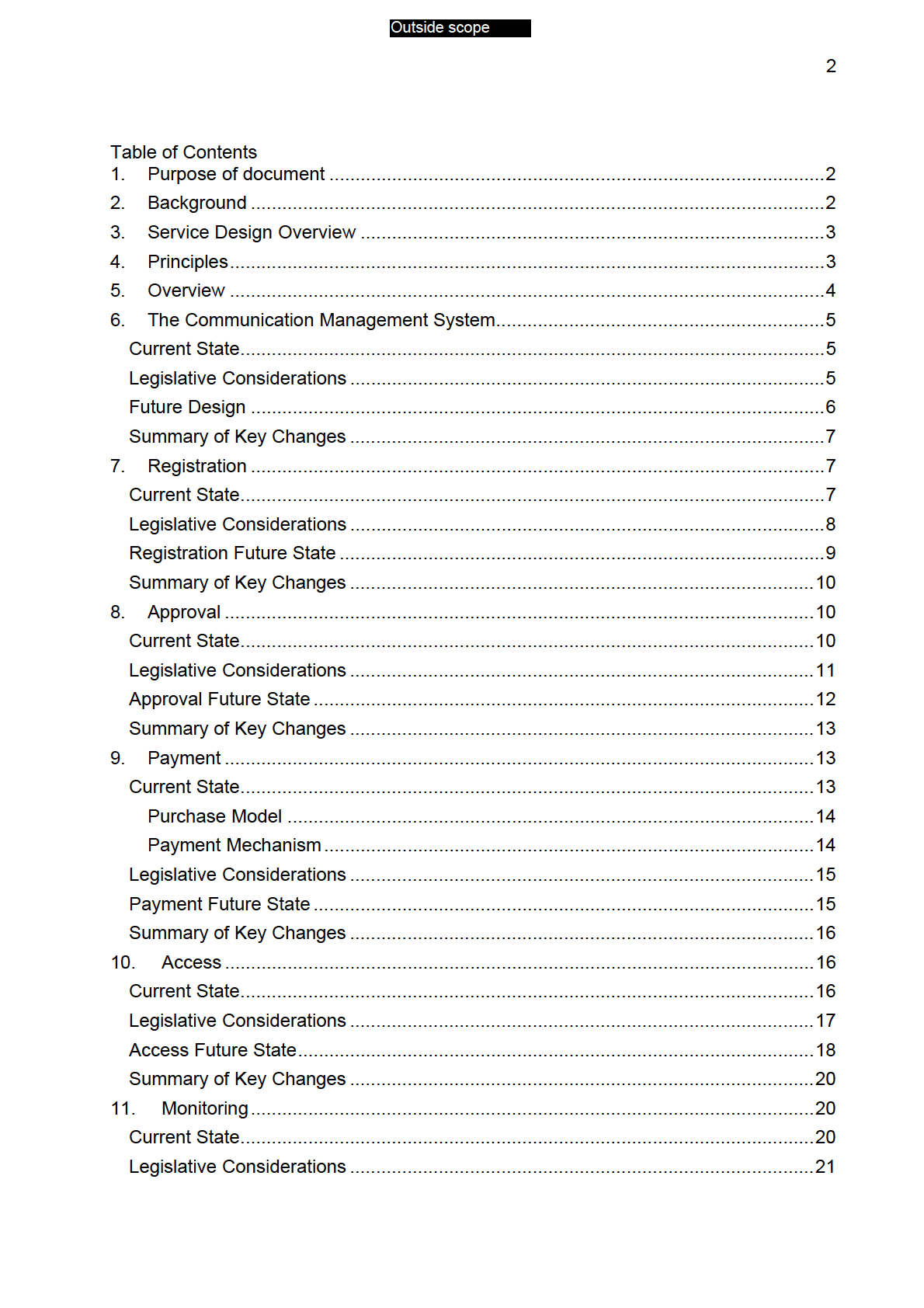
the 1982
under Act
Released
Information
Official

the 1982
under Act
Released
Information
Official

the 1982
under Act
Released
Information
Official
Outside scope
2
1. Purpose of document
This document presents for approval the high level service design to deliver the
Prisoner Communications: Foundation project.
It is to be read in conjunction with the Prisoner Communications Service Brief (approved
by the Business Change Leadership Group on 15th March 2017) and Principles to guide
Prisoner Communications: Foundation (approved by the Project Governance Board on
2nd June 2017).
This High Level Service design is one of three deliverables and sits alongside:
the Vision for the future of Prisoner Communications (approved by the Project
Governance Board on 30th June 2017)
the Roadmap that details the work Corrections will undertake over the coming
years to achieve the Vision (approved by the Project Governance Board on 28th
July 2017).
the 1982
2. Background
How prisoners communicate with whānau and other support people has remained
Act
relatively static for the past twenty years. Aside from private visits, prisoner
under
communications are centred on writing and receiving letters and making outbound
telephone calls. In 2013, following a successful pilot, Corrections introduced incoming
email messages (without attachments).
The two systems used to manage and record outbound telephone calls have now
reached end of life and are in need of replacement. Rather than simply replace the
existing system, Corrections has taken this opportunity to look at prisoner
communication through a wider lens and developed a future Vision for 2027.
Released
Information
This approach has broadened possible solutions beyond simply replacing the existing
telephony system with a new model. It creates a platform to take advantage of and
adapt to future policy and technology change. This will require changes to both the
technology that enables communication and operational business rules.
The Vision has repurposed and repositioned the importance of familial communication
away from simply meeting legislative minimums to focus on building and maintaining
Official
sustainable connections. It is a prisoner centric Vision designed to meaningfully
contribute towards Corrections’ goal of reducing re-offending.
A Roadmap developed from the Vision allows Corrections to lay a sound foundation
now, to enable incremental changes over time to ensure the system for prisoner
communications remains relevant for the rapid changes that occur in this area. The
Roadmap outlines a programme of work over four phases:
The Foundation Project provides for enhancements to the telephone system
which will improve the prisoner’s experience, streamline some business
processes, improve safety and security, and underpin future developments.
2 | P a g e
Outside scope
3
The Enhancing Foundation Project continues to build upon the communication
system introduced for April 2019 and enable some of the new functions that the
system allows for, and personalise access to functions based on the individual
needs of the prisoner.
The Making Mobility Project further enhances the capability of intelligence with
machine learning and introduces additional channels of communications.
The Future Facing Project will take us further into a place where Corrections will
be responsive to new communication technologies as they emerge, which may
include more creative ways of communication, real time interaction via things like
online homework, and take us towards the vision state.
Prisoner Communications Foundation Project is in the preliminary business case phase
of the project lifecycle. The preliminary business case is expected in February 2018,
with implementation by April 2019.
3. Service Design Overview
the
The Foundation Project introduces a national, communication system which will improve
1982
the prisoner’s experience, streamline some business processes, improve safety and
security, and underpin future developments.
A service design approach has been taken to the high level service design for the
under Act
Foundation Project. This means we have:
understood current state and underlying problems (discover phase – workshops,
focus groups and site visits)
explored what our approach is (define phase – Principles and Vision)
designed how the service will operate (develop phase – high level service
design).
The deliver phase will involve the development of a detailed service design and
work required to plan for implementation.
Released
Information
The approach to the development of the Vision, Roadmap and this high level service
design involved the development of a set of agreed principles that will provide the Board
with a framework to ensure the end state of the Vision is aligned across the project and
Corrections key priorities.
The principles were developed through a review of Corrections statutory principles,
Official
strategic priorities and Māori principles, as well as through information gathered from a
series of workshops with frontline staff and focus groups with people in prison.
4. Principles
The key principles developed to guide this project are:
1. Maintaining the safety of the people in the community is our first priority.
2. Opportunities to misuse communication channels will be mitigated.
3 | P a g e
Outside scope
4
3. Communication channels will be adaptable in response to future policy and
technological change.
4. The cost of maintaining contact between people in prison and their whānau and
other support people will be fair.
5. National consistency across how prisoners are enabled to communicate with
whānau and other support people will reduce manual processes.
6. Prisoners will be able to call whānau and other support people without undue
delay, including on entry into prison.
7. Prisoners of all abilities are enabled to communicate effectively through access
to an appropriate range of channels or methods.
8. Prisoners will be able to communicate with others without external interference
and without undue distraction.
the 1982
5. Overview
Prisoners wishing to maintain connections with whānau and other support people
under Act
currently have the following range of communication options available. They may:
receive private visitors, including children
use an audio visual link (AVL) suite for non-contact visits when booths are
unavailable
make outbound telephone calls
send and receive written correspondence, including receiving email.
Each of these methods of communication is currently controlled and managed by
Released
Information
different business rules and when applicable use different technology systems.
Over time it is intended to align and simplify the business rules across all methods of
communication and draw together the technology systems that enable and manage
communications. For example, people in the community wishing to maintain
connections with prisoners will be verified and approved only once, having all relevant
contact information collected at a single point in time. Corrections staff will be able to
Official
see who a prisoner should be maintaining contact with, how frequently, and the
communication channels being used. This information, held in one place, will better
enable Corrections staff to support prisoner rehabilitation and reintegration.
4 | P a g e

the 1982
under Act
Released
Information
Official

the 1982
under Act
Released
Information
Official
Outside scope
7
Summary of Key Changes
a. The communication management system is a nationwide system which captures
all prisoners’ communication information.
b. The communication management system must be able to be controlled at prison
site and unit level.
c. The communication system must distinguish between calls to record for
monitoring and calls that cannot be recorded.
7. Registration
Current State
The current process to register prisoners on the communication management system is
variable and depends on a number of factors:
the
When prisoners are registered on the Prisoner Telephone Call Control System
1982
(PTCCS) differs at each prison site and can occur either on the day a person is
received into prison, or on receipt of prisoner request to have telephone numbers
approved and loaded into the system.
Act
under
How prisoners are registered onto the system is the same across all sites, with
Administration Support Officers (ASO) manually entering prisoner details (and in
some cases approved phone numbers) into the PTCCS.
A Personalised Identification Number (PIN) is auto generated as an output from the
registration process and is used by prisoners in concert with a pre-paid phone card to
activate payphones across the prison site, including making calls to helping agencies.
Timing
Released
Information
The Prison Operations Manual contains the following instruction regarding prisoners
being received:
“Newly arrived prisoners must be allowed 1 free phone call within New Zealand
for the purpose of advising their next of kin (Corrections Regulations 2005,
regulation 87). This phone call must be recorded for monitoring purposes but is
Official
unlikely to be able to be made on a prisoner pay phone due to the PIN and pre-
approved phone number process not being started. C.02.Res.04 Initial phone call
details the process for making the initial free call from any non-prisoner
payphone. This process ensures the initial call is recorded and must be followed
for all new arrival initial free phone calls.”
In practice, this first and free call is not restricted to next of kin for the purpose of
advising them of a prisoner’s location and is used to make arrangements for issues
ranging from employment to childcare. The call takes place in either the receiving office
or on the unit the following day from a non-PTCCS telephone.
7 | P a g e

the 1982
under Act
Released
Information
Official

the 1982
under Act
Released
Information
Official
Outside scope
10
profile for the purpose of the first call. The call itself could take place during reception or
on the unit the following day.
Enabling the first phone call to take place on the telephone system immediately
following registration will reduce pressure on custodial staff. In addition, allowing
immediate access to a range of limited helping agency numbers, and their lawyer,
enables the prisoner to receive advice and support for a range of issues like mental
health or drug and alcohol addiction.
Ultimately, this profile will become ‘front page’ information for Corrections staff. Staff
will be able to see at a glance who a prisoner in their care is permitted contact with and
whether that contact is occurring. This will enable Corrections staff to better understand
when prisoners are isolated from their social networks and facilitate contact to enable
successful reintegration.
Summary of Key Changes
the
a. Registration for the communication system will happen as a person is received
into prison.
1982
b. Corrections need immediate access to information about court orders in place to
protect victims.
Act
under
c. Once registered, the communication system must allow immediate access to a
‘first phone call’ to family, and access to legal advisors and support services.
d. Prisoner registration onto the communication system must include a unique
biometric identifier which enables access to communication devices and tools.
8. Approval Released
Information
Current State
Following the first call and registration on the PTCCS a prisoner can request approval to
make telephone calls to specific people, up to a maximum of 10 numbers.
The approval process is initiated by the prisoner when they complete a form
Official
(C.02.Form.01.). The form requests names, addresses, telephone numbers, and
whether a court order is in place in relation to the person (or anyone in the household)
and their interaction with the prisoner.
Corrections Officers are required to check IOMS for information about court orders, and
make contact with the call recipient to check whether they wish to receive telephone
calls from the prisoner. Approval is denied in the when:
the person is subject to a protection order
there is no reply (usually after a few attempts)
the person is unknown at the number
10 | P a g e

the 1982
under Act
Released
Information
Official

the 1982
under Act
Released
Information
Official
Outside scope
13
Where prisoners make requests for contact, and those contact details are on a
centralised list of banned numbers, an alert will appear preventing approval for that
channel of communication.
Information collected during induction relating to prisoner physical, social, cultural and
the needs of differently abled prisoners that will impact on a prisoner’s ability to maintain
connections with whānau and other support people will be visible and considered to
enable appropriate communication channels. To enable prisoners to maintain contact
Corrections staff will plan how communications will be funded and when the
communication is best to take place.
The foundation stage will introduce a new approval process for prisoner to prisoner
mail. Section 105 of the Corrections Act states “that no prisoner at any prison may send
mail to another prisoner without first notifying the prison manager of the prisoner’s
intentions”.
The introduction of an approval process will maintain the integrity of non-association
orders and limit prisoner miss-use of this form of communication. Where prisoner to
the
prisoner mail is approved, this will be recorded on each prisoner’s communication
1982
profile. In time, where appropriate (such as when both parents are imprisoned), the
channels of approved communication between prisoners will broaden.
under Act
Summary of Key Changes
a. The decision making process for approvals will have two steps: firstly the
approval of who the prisoner wishes to communicate with and how, and secondly
the verification of those communication channels.
b. Prisoners can initiate requests for communication methods and changes via the
communication device self service functions.
Released
c. An approval process for prisoner to prisoner mail will be introduced.
Information
d. All outbound mail will require a printed address label.
The next steps in the Enhancing Foundation Programme will align approvals across
core systems for all types of communication, including visits, and centre on the
development of a communications plan that will detail access requirements for
Official
prisoners.
9. Payment
Current State
Section 77(6) of the Corrections Act states “Every prisoner who makes an outgoing
telephone call must meet the cost of that call, except where this Act, or any regulations
made under this Act, provide otherwise.”
13 | P a g e
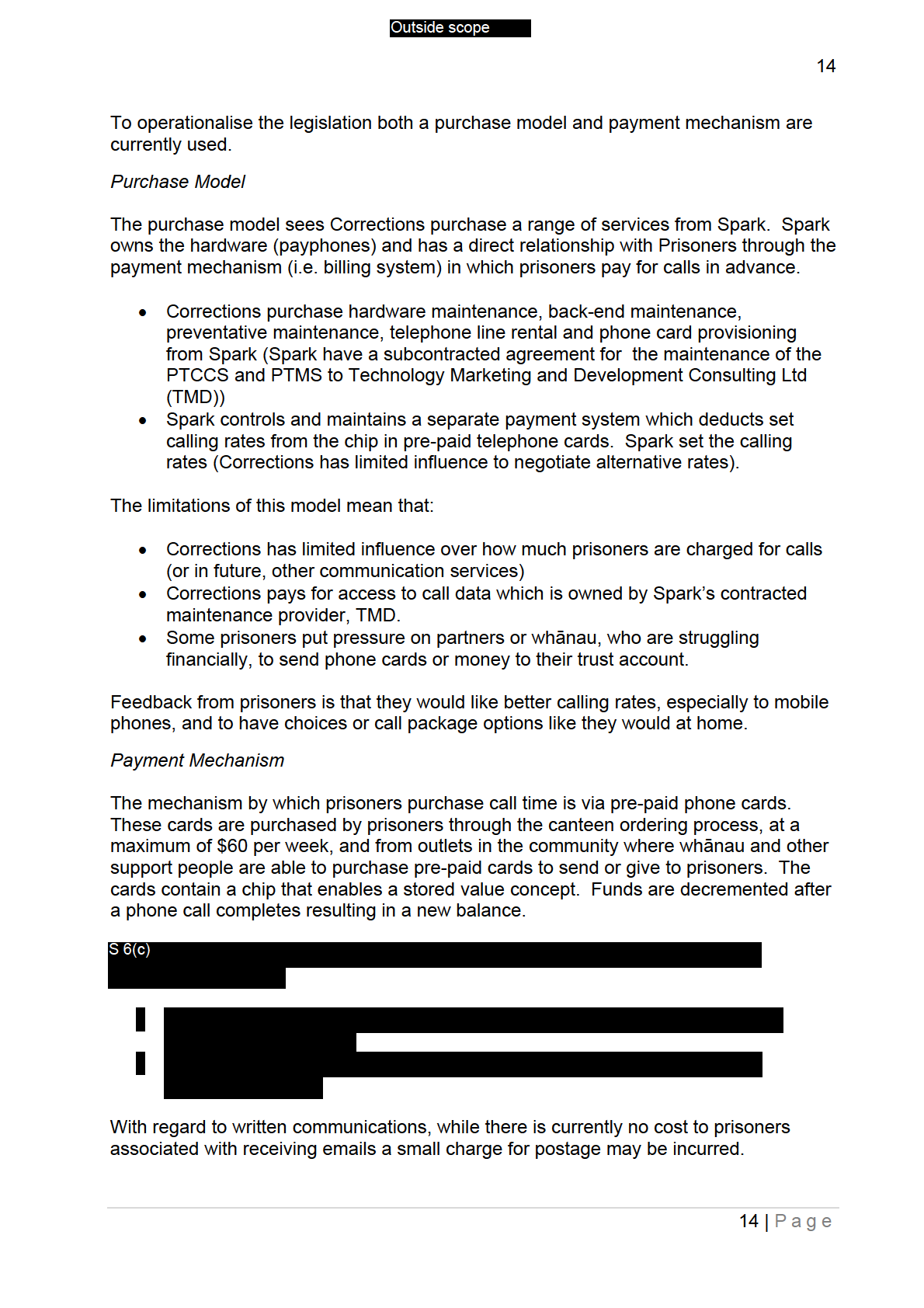
the 1982
under Act
Released
Information
Official
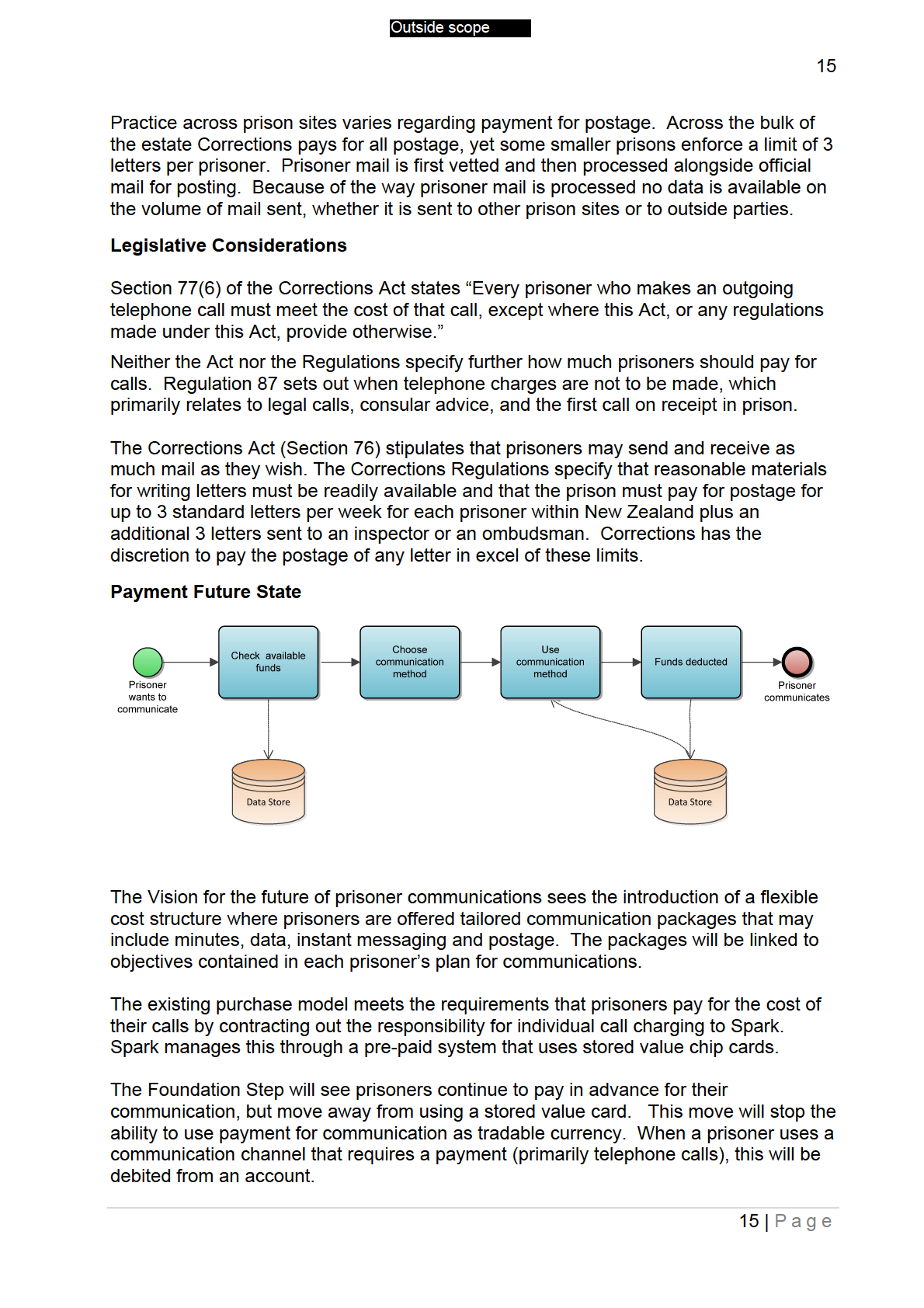
the 1982
under Act
Released
Information
Official
Outside scope
16
Corrections will need to consider whether the billing system is out-sourced to a provider,
as the current system operates, or whether the identified limitations are better overcome
through the direct provision of a billing system.
As outbound email functions become available for prisoners these will be free from
charge.
All outbound correspondence will be free from charge, as it is envisaged over time
prisoners will transition from written correspondence to more voice based and e-written
correspondence.
Summary of Key Changes
a. Where payment for communication is required it will occur on a pre-paid basis.
b. Payment will debit directly from an account.
the
c. All written communication will be free from charge.
1982
10. Access
under Act
Current State
There are two key factors to consider when discussing access to communication. The
first relates to available resources, such as the number of communication devices
across the prison estate. The second relates to the time prisoners have available to use
voice to voice or other means of communication.
There are 493 pay phones across 17 sites (excluding New Plymouth) servicing a prison
Released
population of approximately 10,300 prisoners.
Information
The existing telephone units are static devices installed on walls in communal areas in
residential units and/or exercise yards outside. There are often two phones per
residential unit, but this varies across the estate. The placement of the payphones
belies the apparent 20:1 ratio of payphones to prisoners as special units (e.g. at-risk
units and self care units) house fewer prisoners. A unit will typically house 60 prisoners,
Official
although this again varies across the estate.
Access is regulated by cost and availability. Whether prisoners can afford to make
outbound telephone calls is their first determinant to access. The second is time and is
regulated by their schedule and whether they participate in activities such as
employment, education or treatment during the day.
Corrections has relatively recently introduced an 8am – 5pm regime for high security
prisoners and those on remand. Outside of those hours prisoners are restricted to their
cells. Reflecting this change, peak calling time across the prison estate occurs between
3pm and 4pm.
16 | P a g e
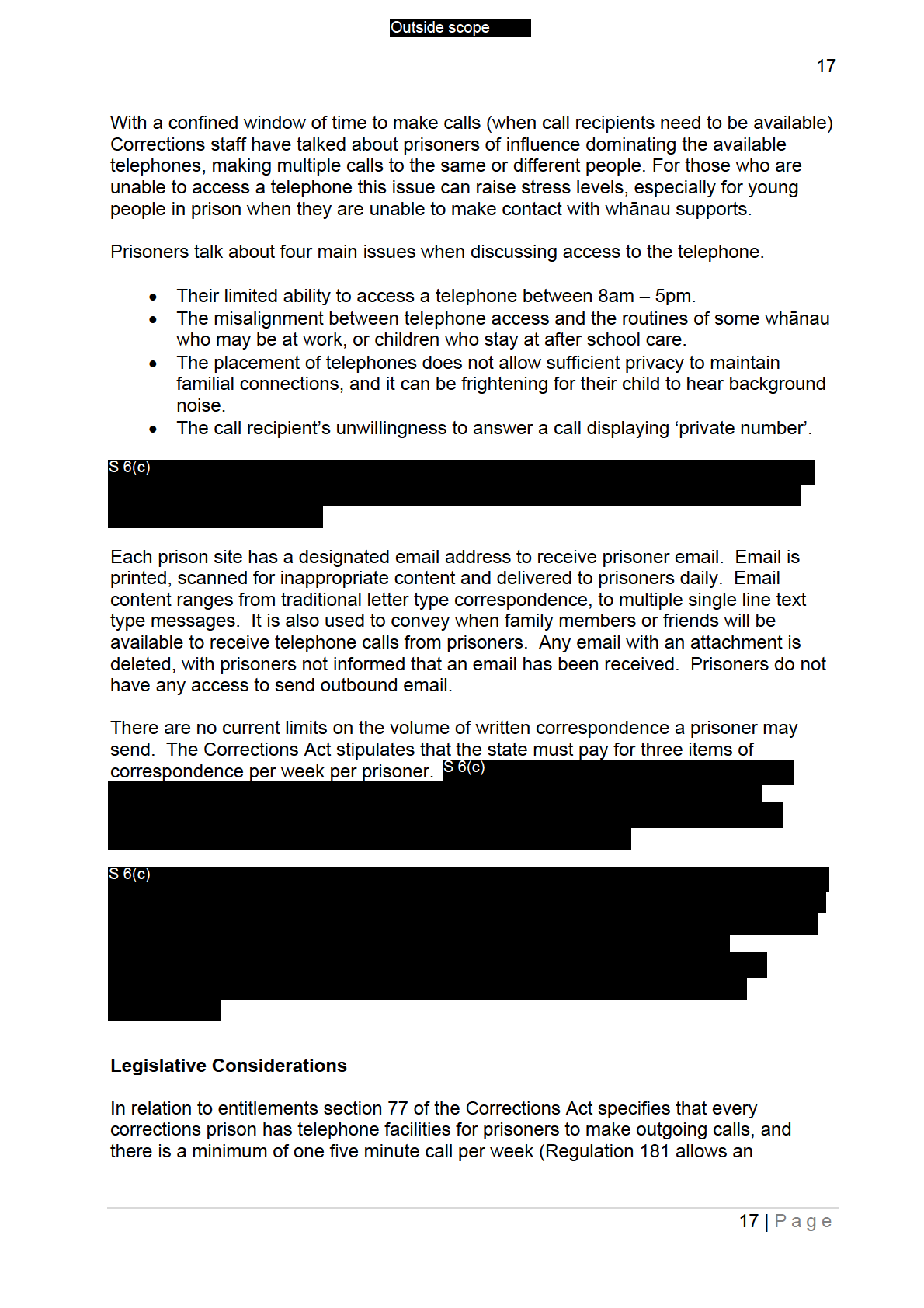
the 1982
under Act
Released
Information
Official
Outside scope
18
additional five minutes per week minimum for young prisoners) for telephone calls, in
addition to any calls made to an official agency or prisoners legal adviser.
The Disability Code of Rights is based on The HDC Code of Health and Disability
Services Consumers' Rights Regulations 1996. There are 10 rights, of which ‘5. The
Right to Effective Communication’, is of particular relevance. Corrections’ material
provides further information about this right.
Every prisoner has the right to:
effective communication in a way the prisoner can understand. Use an
interpreter if it is needed.
an environment that enables both prisoner and provider to communicate openly,
honestly, and effectively.
Out of Scope
In addition to telephone calls, section 76 of the Corrections Act allows prisoners to send
and receive as much mail as they wish
the
(mail is defined as any letter, package, parcel, or
postcard sent or delivered to or by a prisoner). Regulation 83 requires prisons to pay
1982
for the first three letters per week sent by a prisoner, and can pay for more if the
manager of the prison so decides. In practice, it is difficult to monitor how many letters
a prisoner sends per week in terms of managing a three free letter limit.
Act
under
Access Future State
In future prisoners will have a wider range of communication devices and methods
available that are based on their individual need and circumstance. The range and mix
of devices available will include static devices in fixed locations to hand held devices.
Prisoner access will be determined during the induction interview and will align with and
Released
be based, among other things, on security classification and sensory and/or cognitive
Information
abilities. As prisoners progress through their sentence and security classification levels
decrease access to more flexible communication channels will occur.
For example, maximum or high security prisoner may have to access their
communication from fixed devices, medium security prisoners may be able to ‘borrow’
devices at agreed times, and low security prisoners may be able to have a device with
Official
them at all times.
When prisoners are located away from key support people and regular visits cannot
occur greater access to other methods of communication will be actively facilitated.
The prisoner communication profile, which will show who a prisoner can and cannot
communicate with, will also hold information on actual communication that occurs. For
example if a prisoner has approval to communicate with their partner via voice to voice
and face to face via technology, the profile will show the number and times this is
occurring.
18 | P a g e
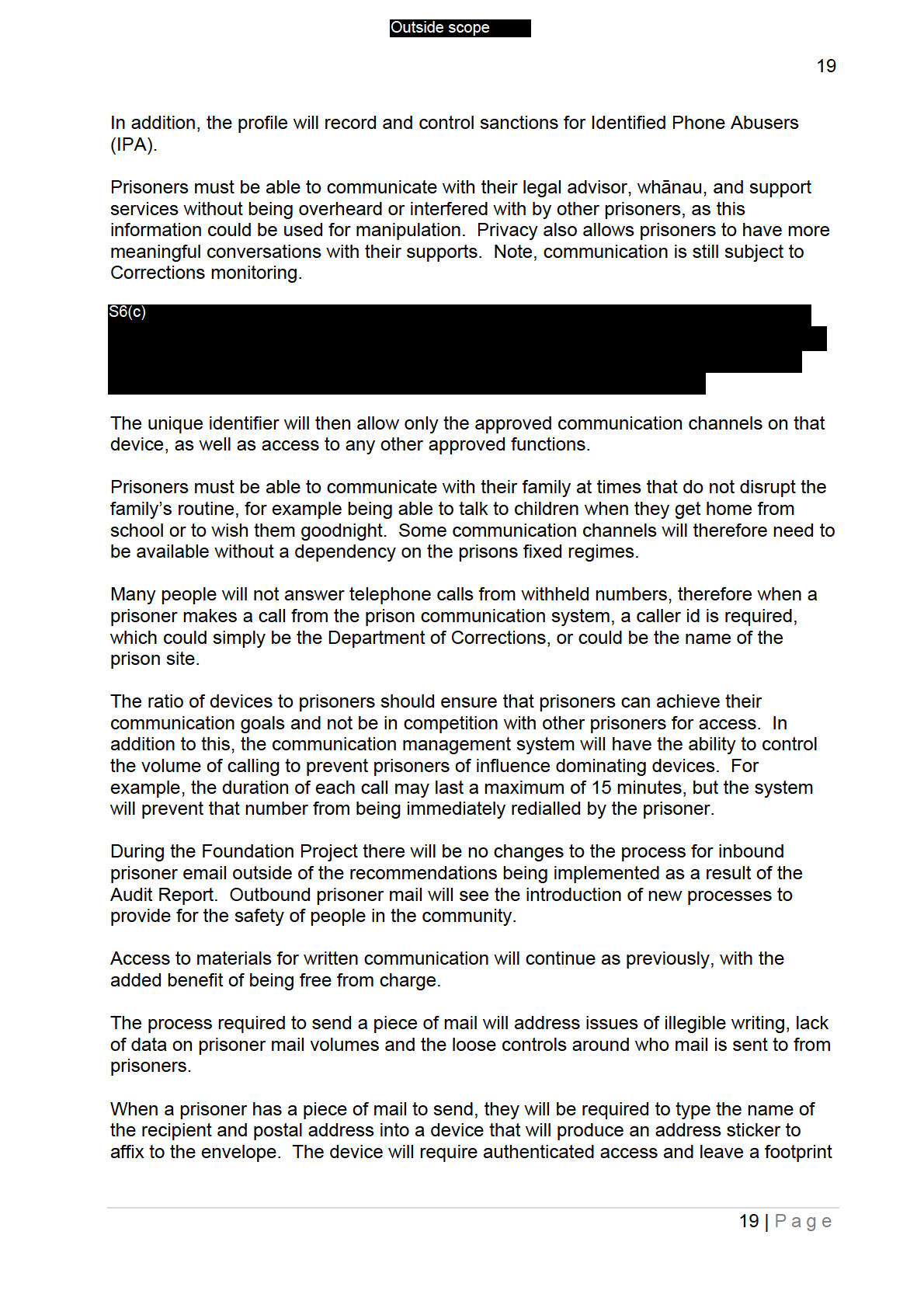
the 1982
under Act
Released
Information
Official
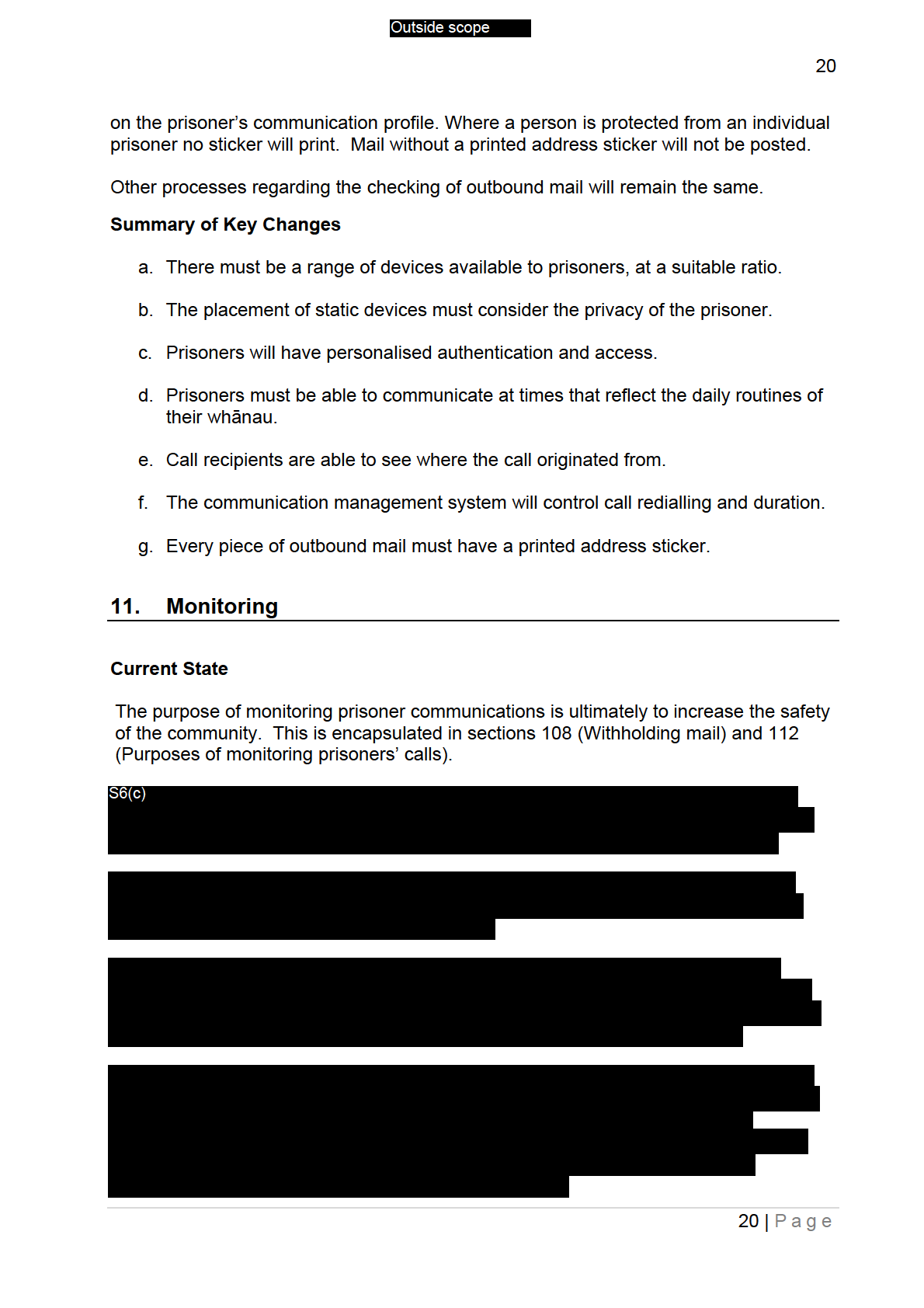
the 1982
under Act
Released
Information
Official

the 1982
under Act
Released
Information
Official
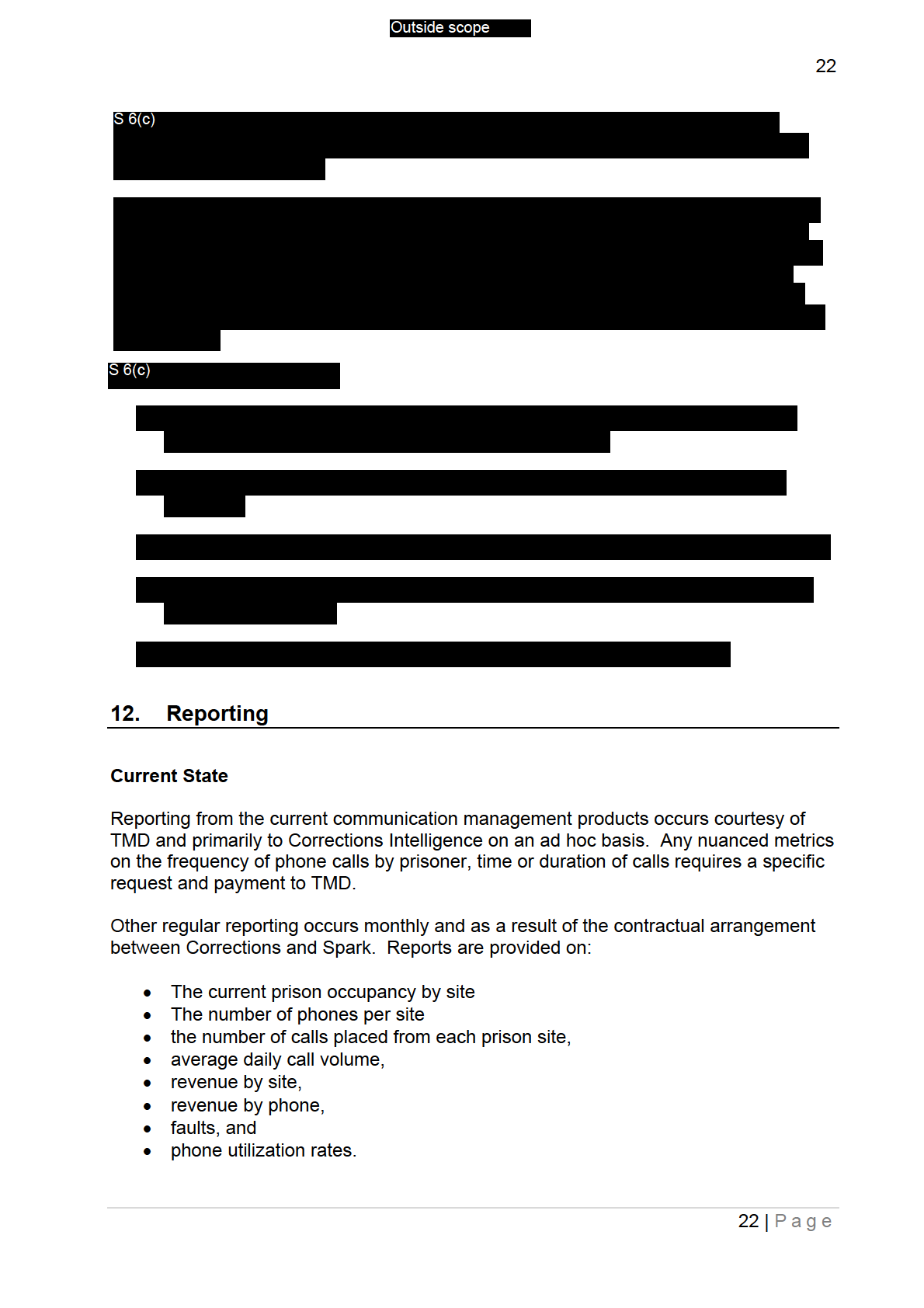
the 1982
under Act
Released
Information
Official
Outside scope
23
Future State
Corrections will retain the ability to draw reports from the communication management
system without incurring further charge. Reporting requirements will further understood
during the detailed design phase, but at a minimum will include reporting on the
volumes of communication data sent, whether by voice to voice, or mail.
Summary of Key Changes
a. Corrections will retain the ability to draw nuance reporting directly from the
communication management system.
the 1982
under Act
Released
Information
Official
23 | P a g e
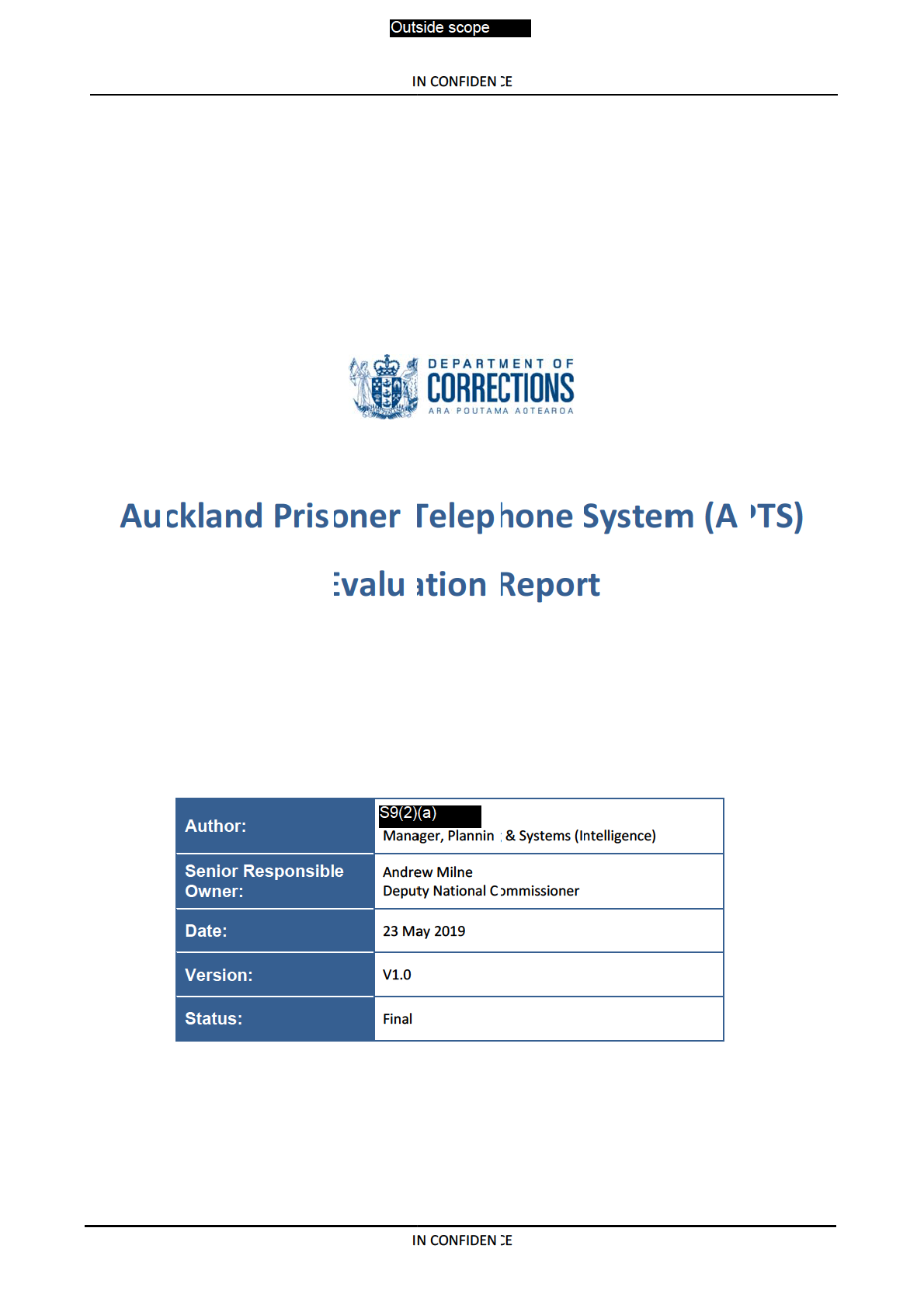
the 1982
under Act
Released
Information
Official
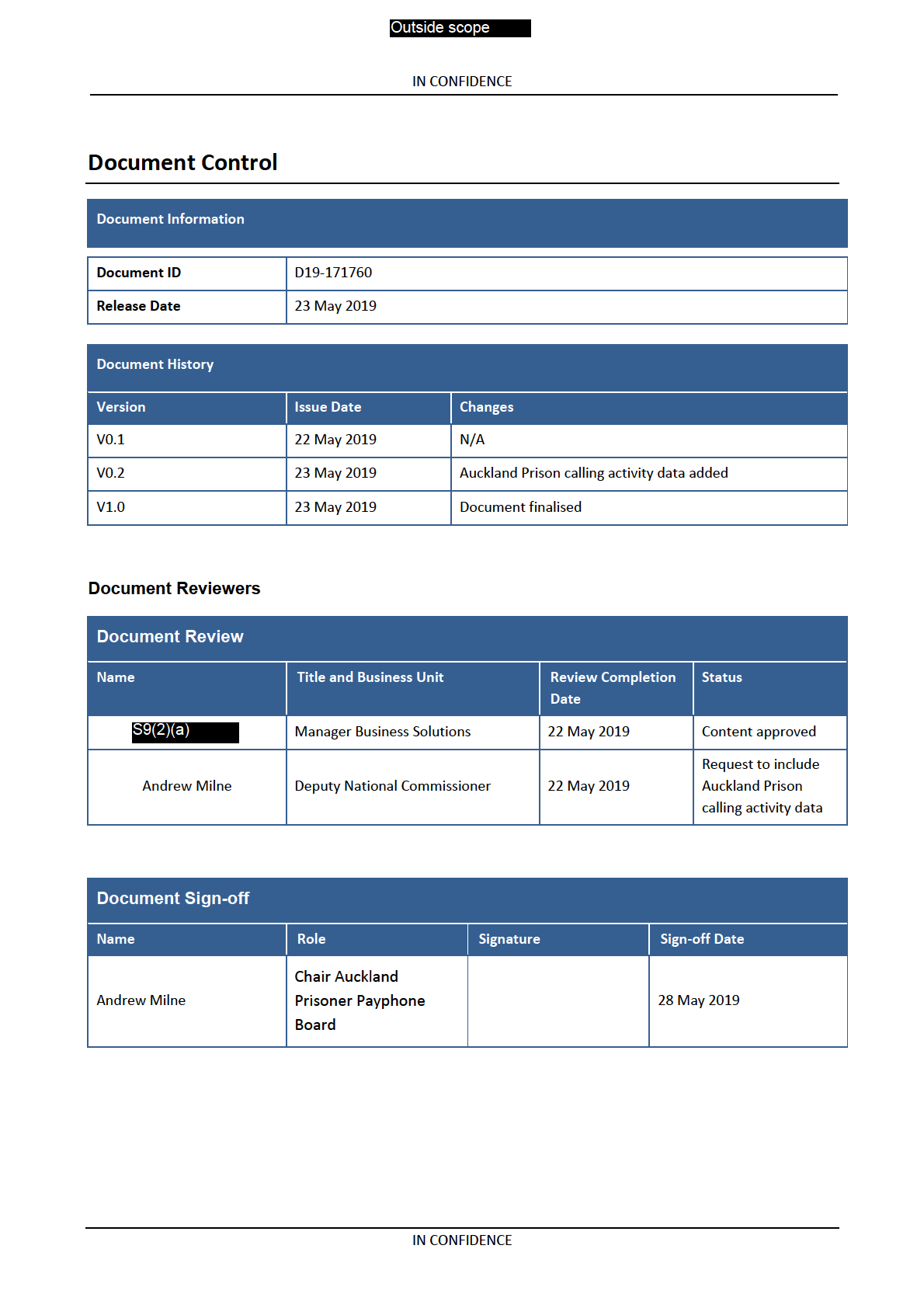
the 1982
under Act
Released
Information
Official
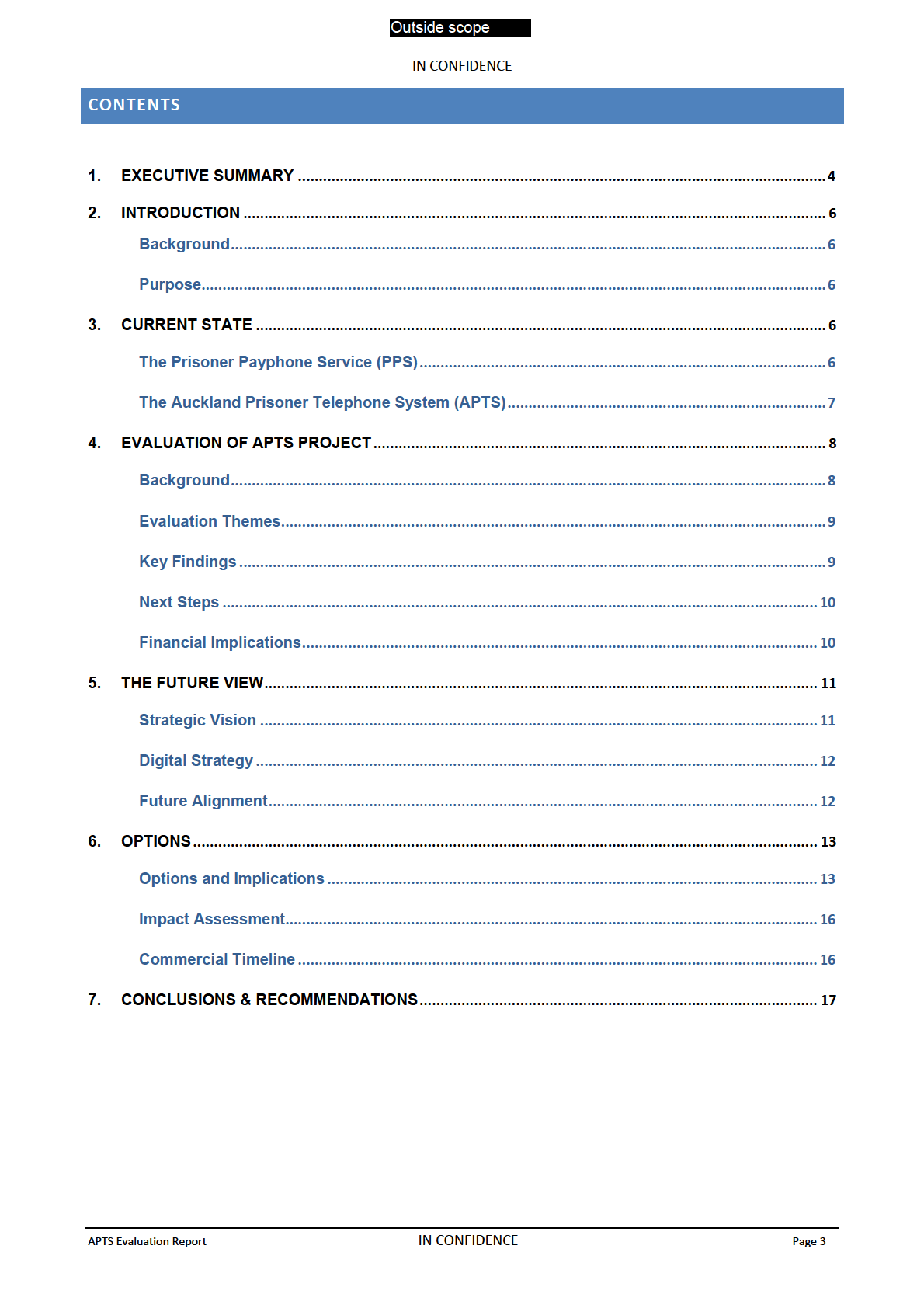
the 1982
under Act
Released
Information
Official
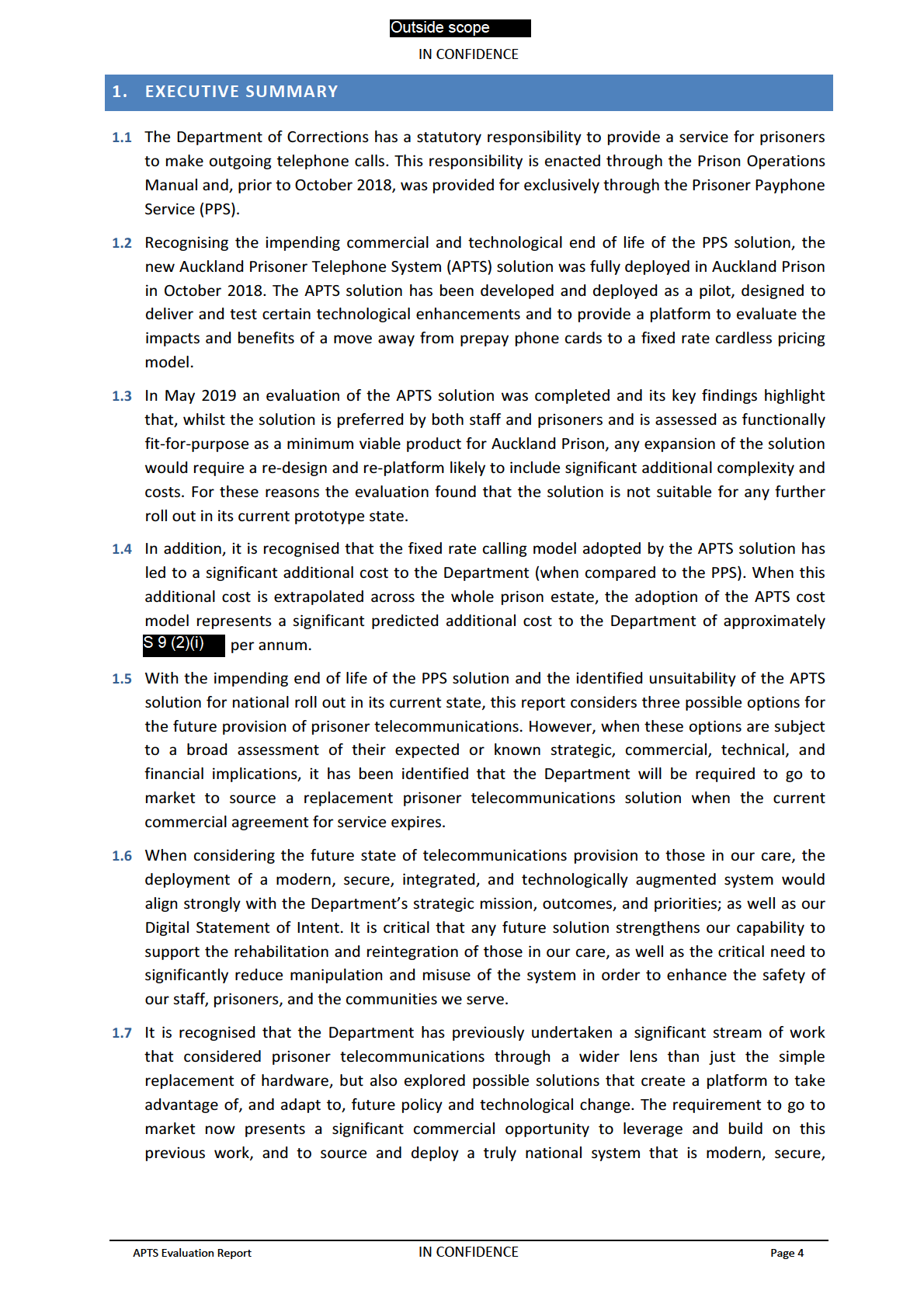
the 1982
under Act
Released
Information
Official
Outside scope
IN CONFIDENCE
integrated, and technologically augmented and fully satisfies all identified high level
requirements of the Department.
1.8 The requirement to go to market now represents a major procurement for the Department, and
will require S 9 (2)(i)
1.9 It is now critical that the Department identifies, sources, and deploys a fit‐for‐purpose
replacement solution within the available timeframes, and recommendations are provided in
this report to ensure the timely commencement and delivery of this process.
the 1982
under Act
Released
Information
Official
APTS Evaluation Report
IN CONFIDENCE
Page 5
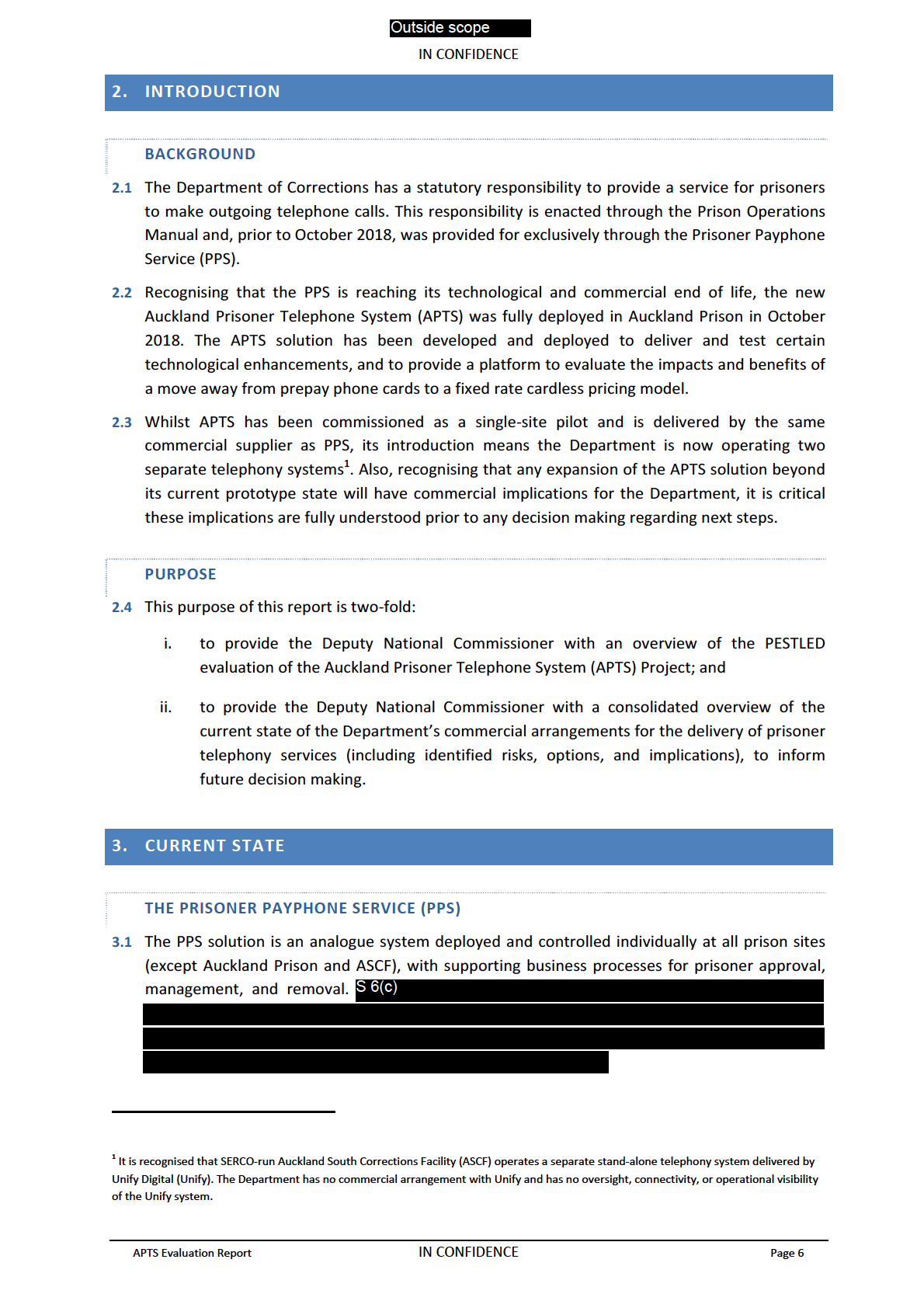
the 1982
under Act
Released
Information
Official


Outside scope
IN CONFIDENCE
3.2 9(2)(i)
3.3 It is recognised that the use of payment cards and high calling rates is becoming increasingly
cost‐prohibitive for prisoners, as standard market rates for payphone to mobile calls are
expensive relative to calls from payphones to home landlines. This issue is compounded by
declining popularity of home landlines, and it is recognised that the current PPS calling rates do
not reasonably align with current societal norms of communication.
3.4 Whilst PPS service continuity is guaranteed by the supplier to S 9 (2)(i)
it is recognised that
the solution is S 6(c)
The system also relies
on the use of prepay phone cards S 6(c)
3.5 Whilst the Department has commenced discussions with the supplier to explore the potential
extension of the PPS service schedule S 9 (2)(i)
the
1982
3.6 When considering staff, prisoner, and community safety, S6(c)
Act
under In addition, the high cost
of PPS calling rates often places increased financial pressure on partners and family members.
3.7 As the current PPS call control and monitoring systems are S 6(c)
Released
Information
THE AUCKLAND PRISONER TELEPHONE SYSTEM (APTS)
3.8 The APTS project was commissioned in December 2017 to deliver a new phone system timed to
coincide with the opening of the new maximum security facility at Auckland Men's Prison in July
2018. The project’s objective was to replace the existing analogue PPS system that charges
prisoners per call at (landline and mobile) market rates, with a modernised system that uses
fixed prepay call plans.
Official
3.9 The current APTS cost model is based on call cost recovery from the Department (currently a
fixed fee based upon a calculation of average monthly call volume/costs (at market rates) in the
period preceding solution implementation), a fixed site maintenance fee (based upon the
number of phones), and solution development cost recovery during the development phase
amortised across a three‐year term.
3.10 Prisoners at the new Auckland Prison now pay a fixed fee of $2 per week from their trust
accounts, and are able to make all their calls (within a schedule of 15 approved numbers) for a
duration of 15 minutes per call. Once the APTS solution was fully deployed in October 2018,
APTS Evaluation Report
IN CONFIDENCE
Page 7
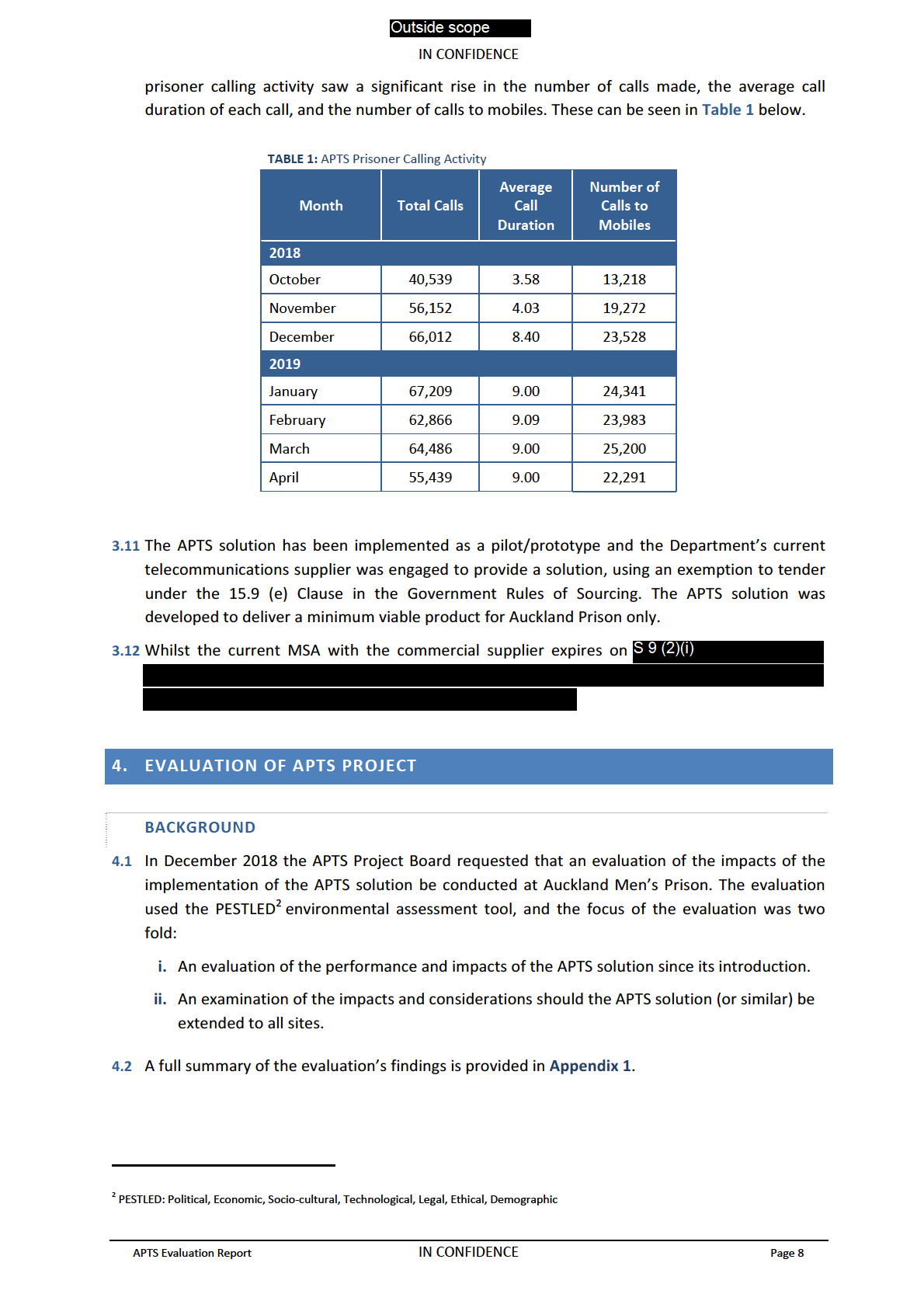
the 1982
under Act
Released
Information
Official
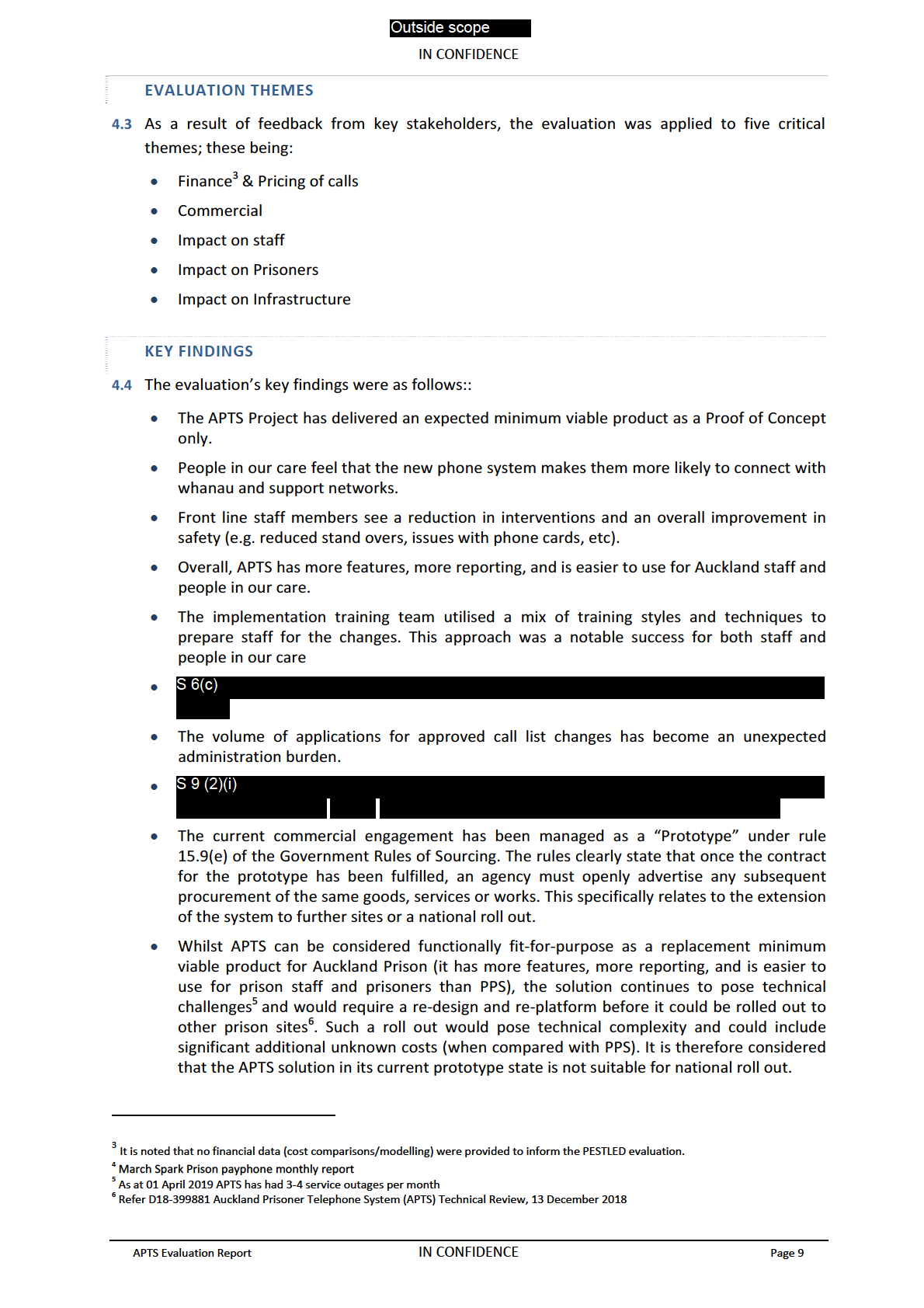
the 1982
under Act
Released
Information
Official
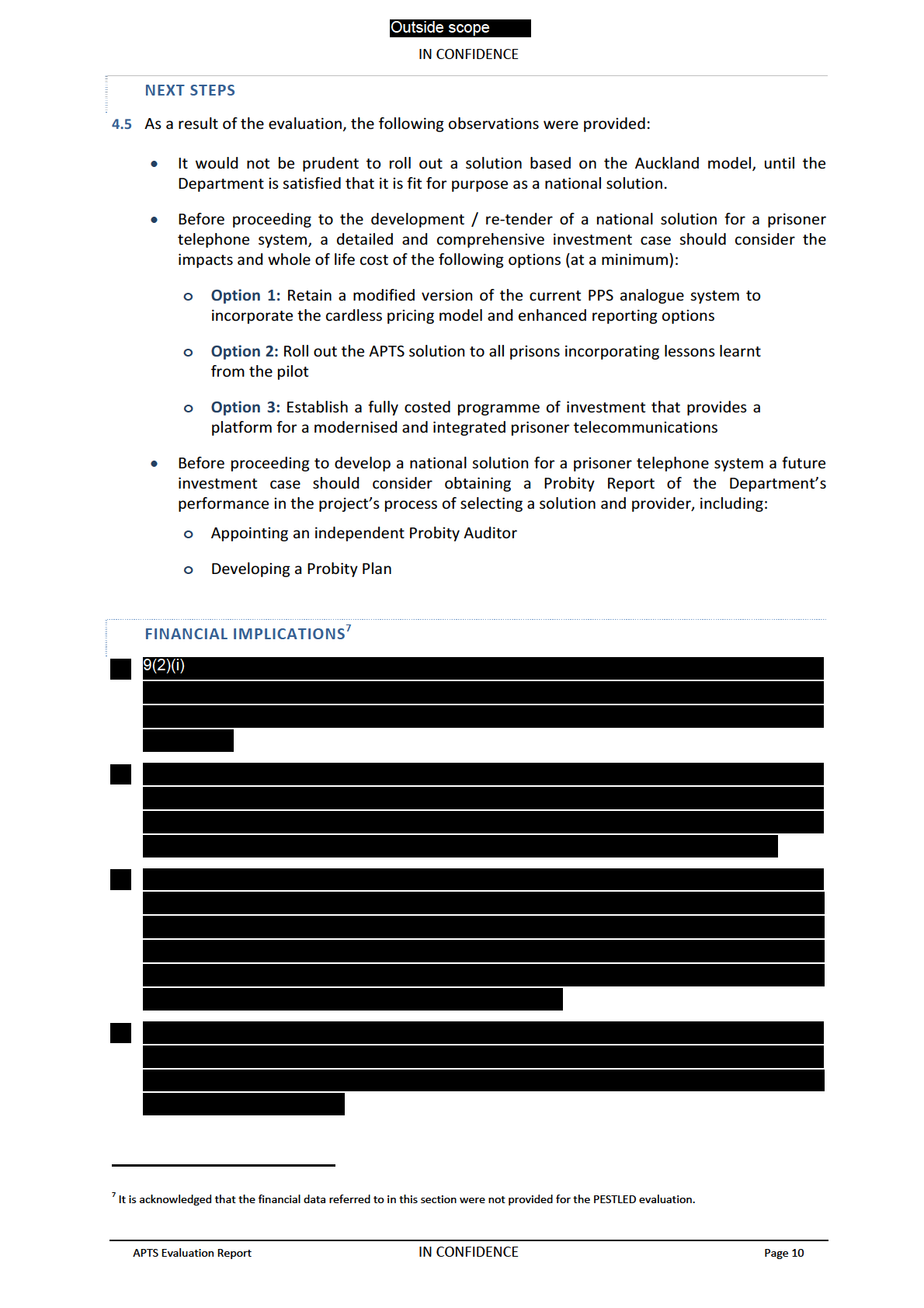
the 1982
under Act
Released
Information
Official
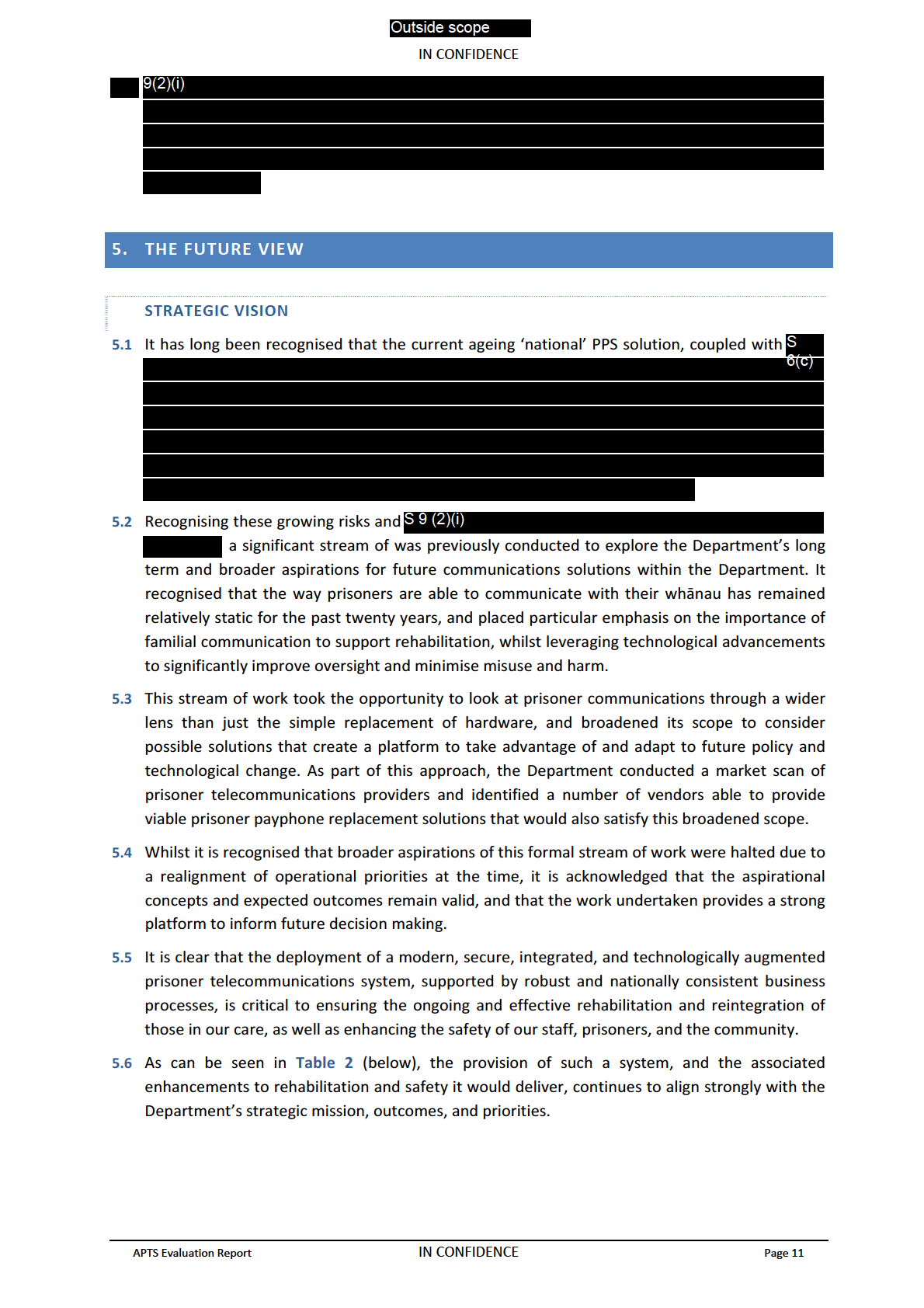
the 1982
under Act
Released
Information
Official
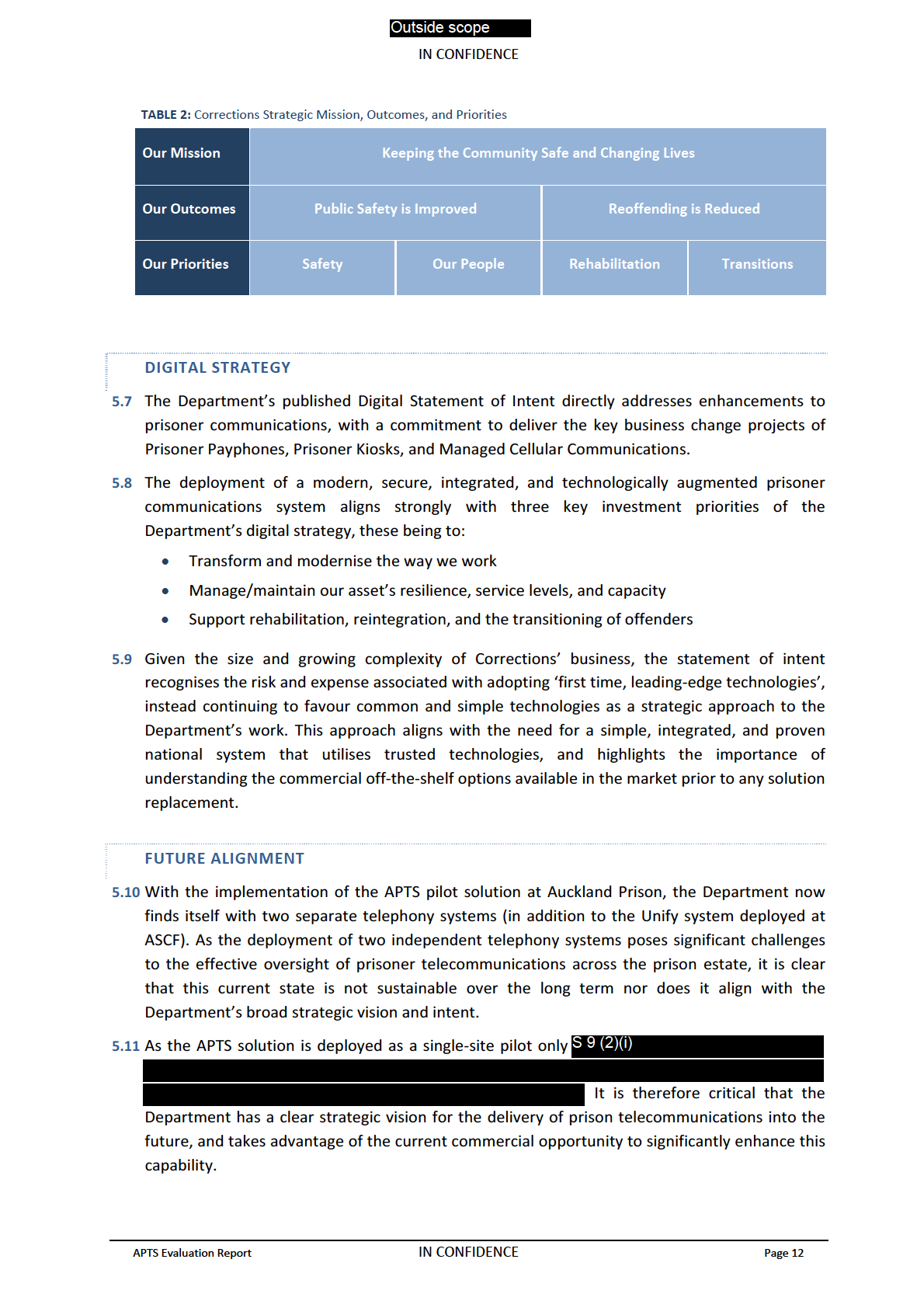
the 1982
under Act
Released
Information
Official
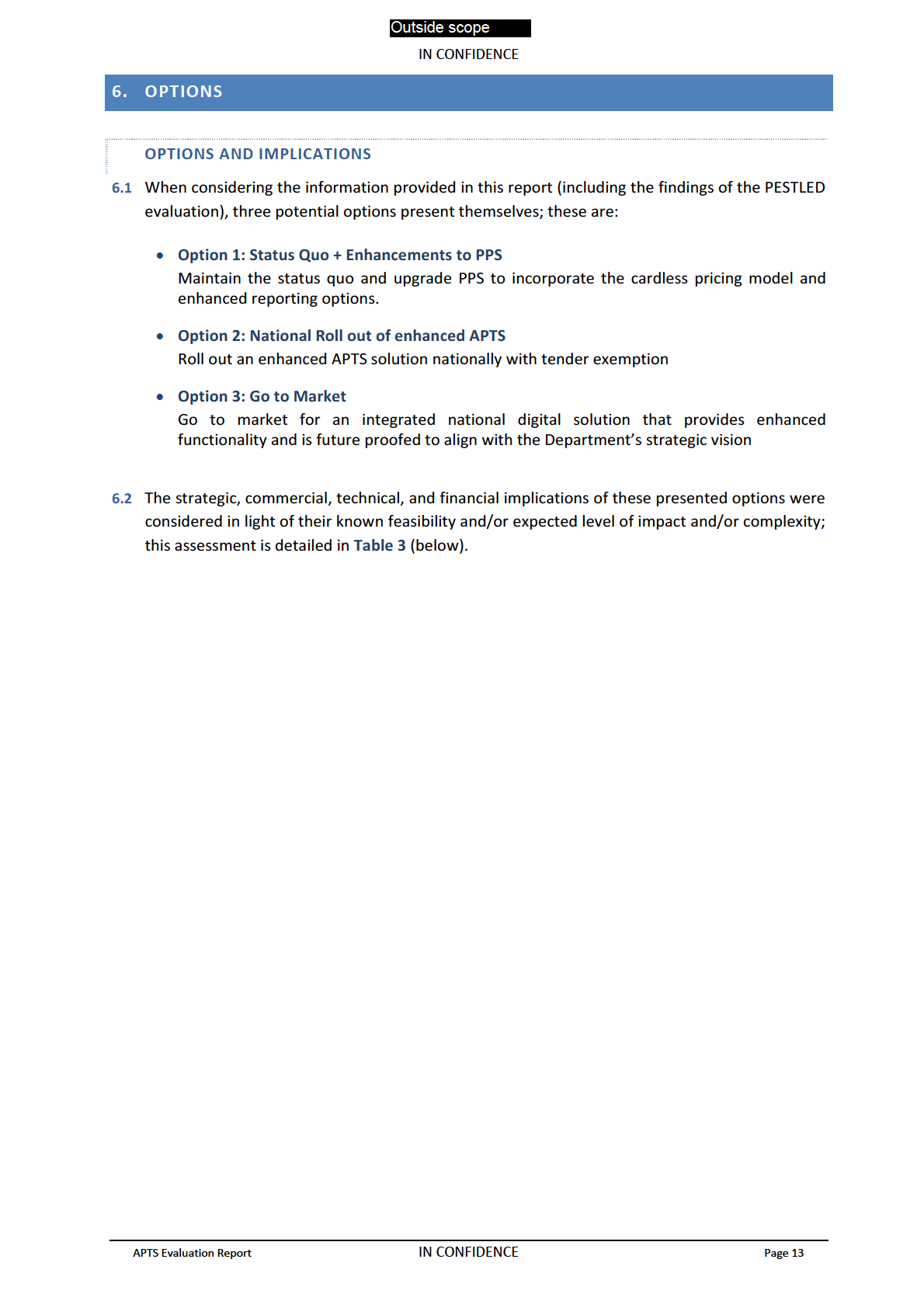
the 1982
under Act
Released
Information
Official
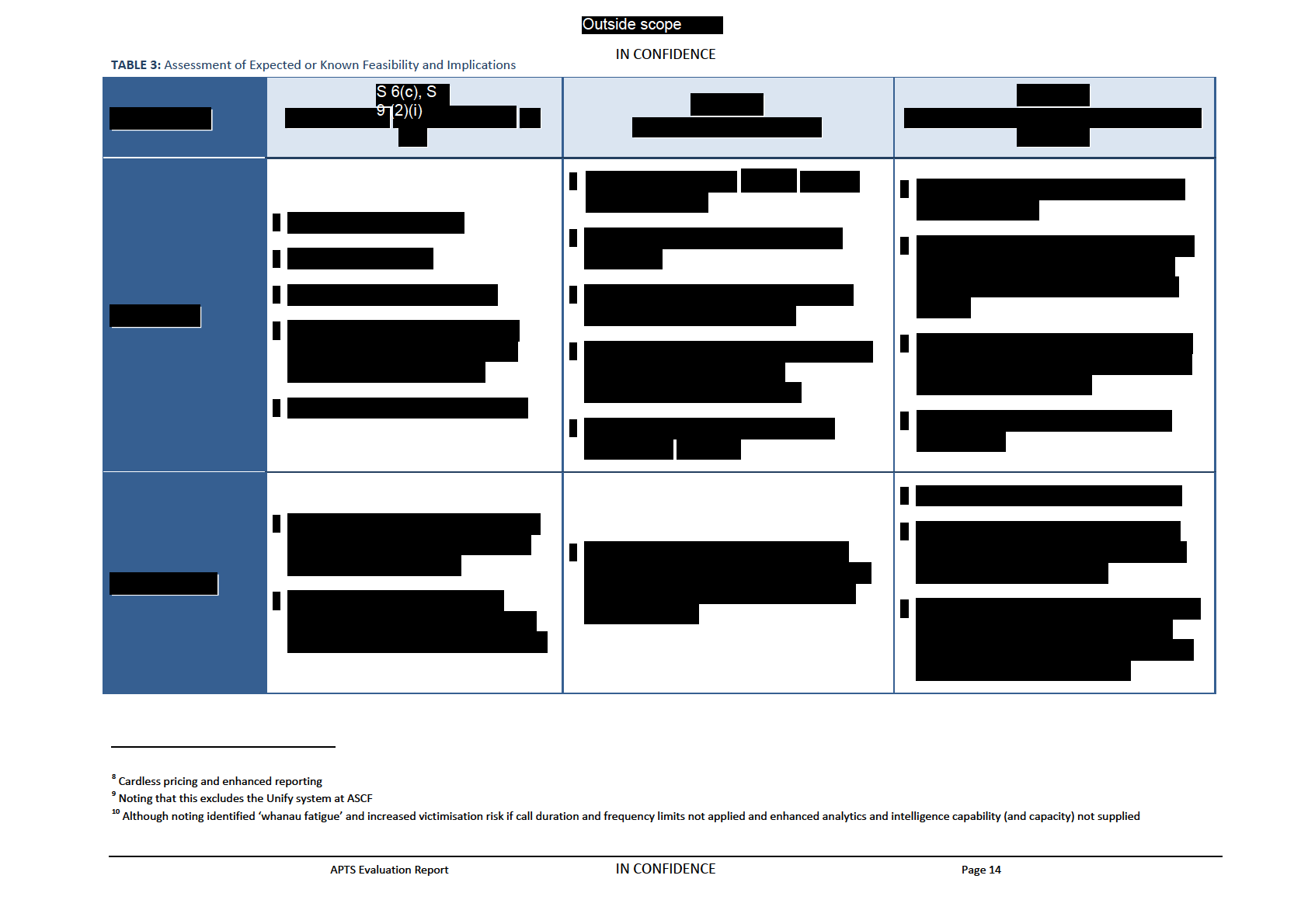
the 1982
under Act
Released
Information
Official
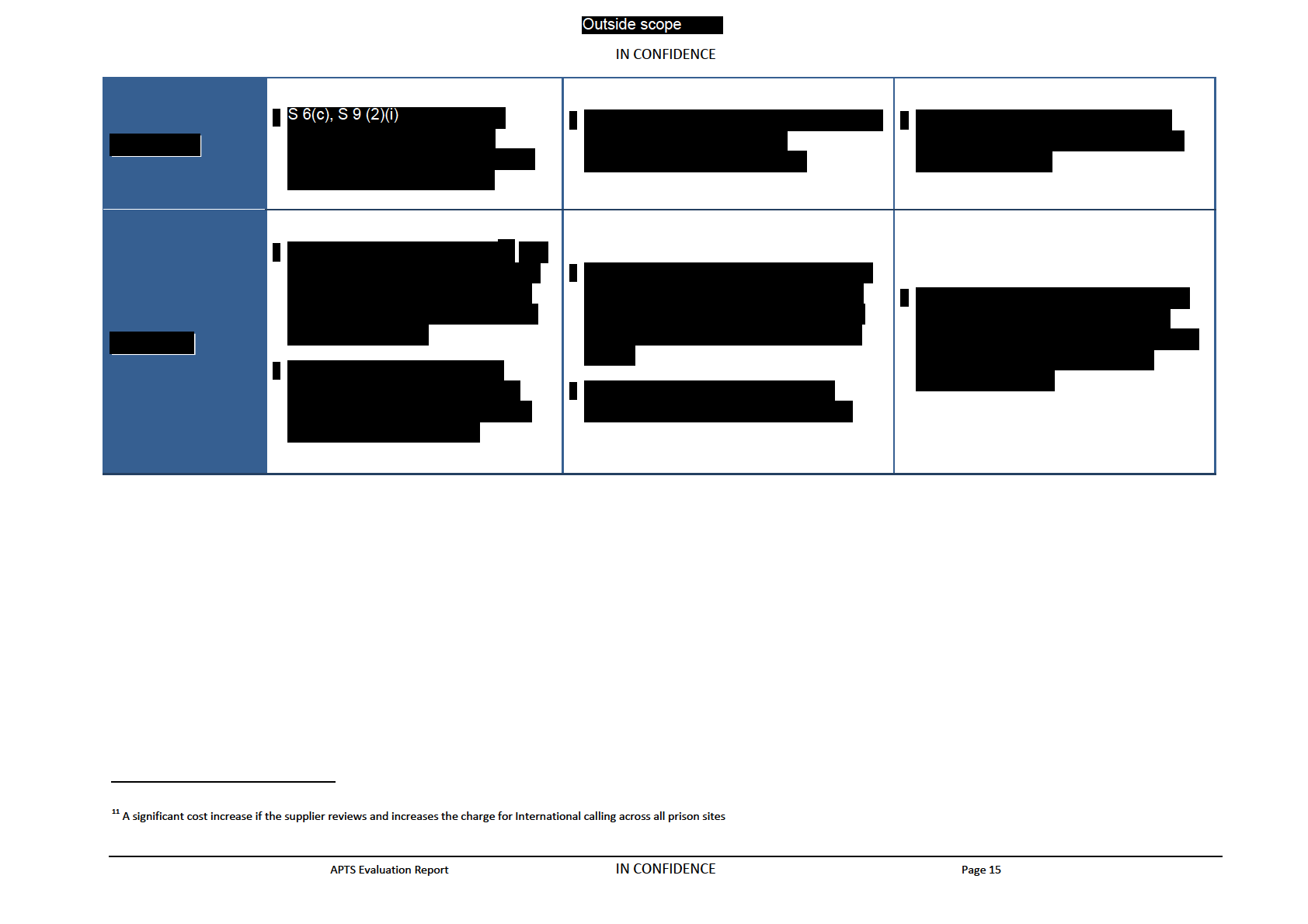
the 1982
under Act
Released
Information
Official
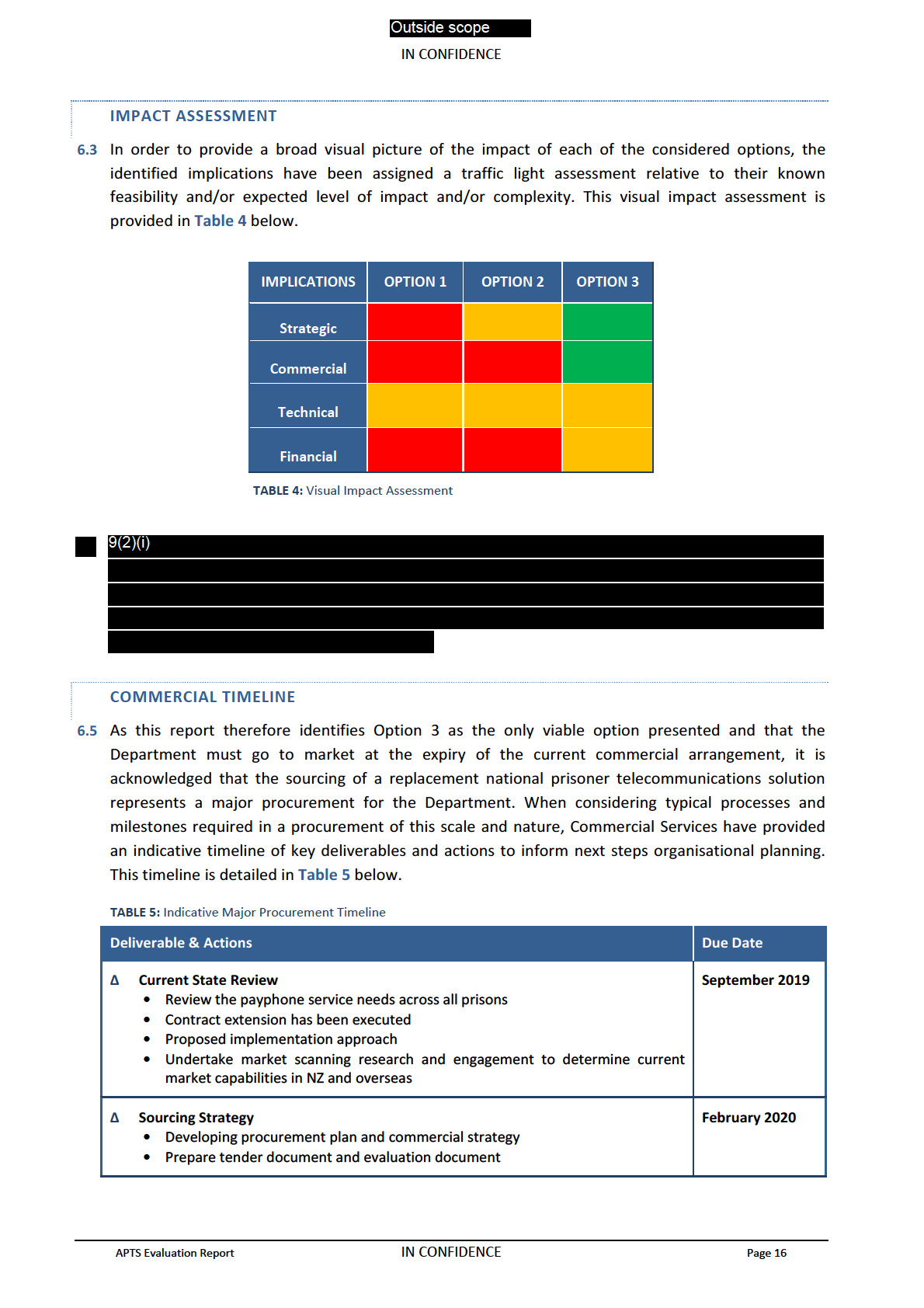
the 1982
under Act
Released
Information
Official
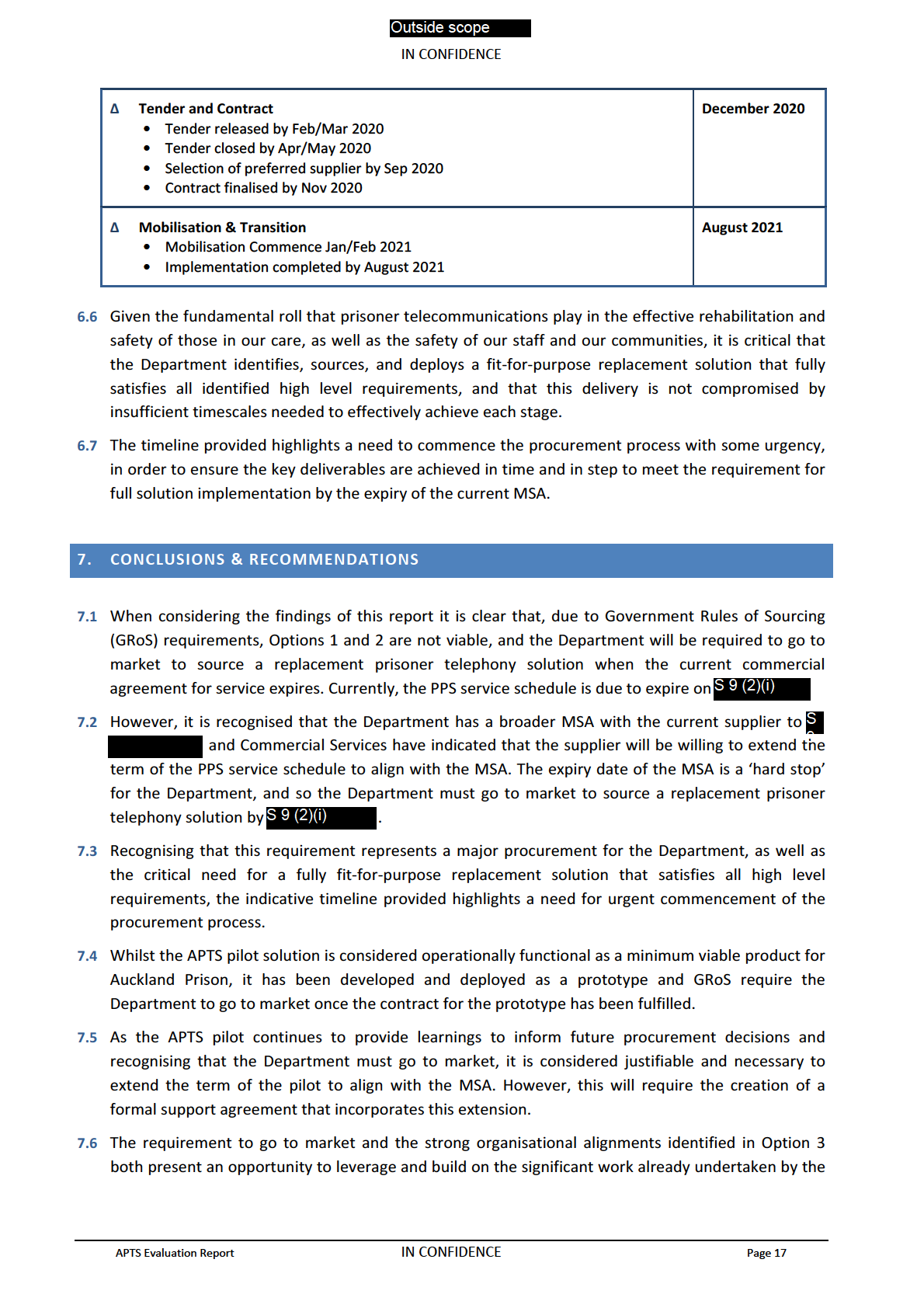
the 1982
under Act
Released
Information
Official
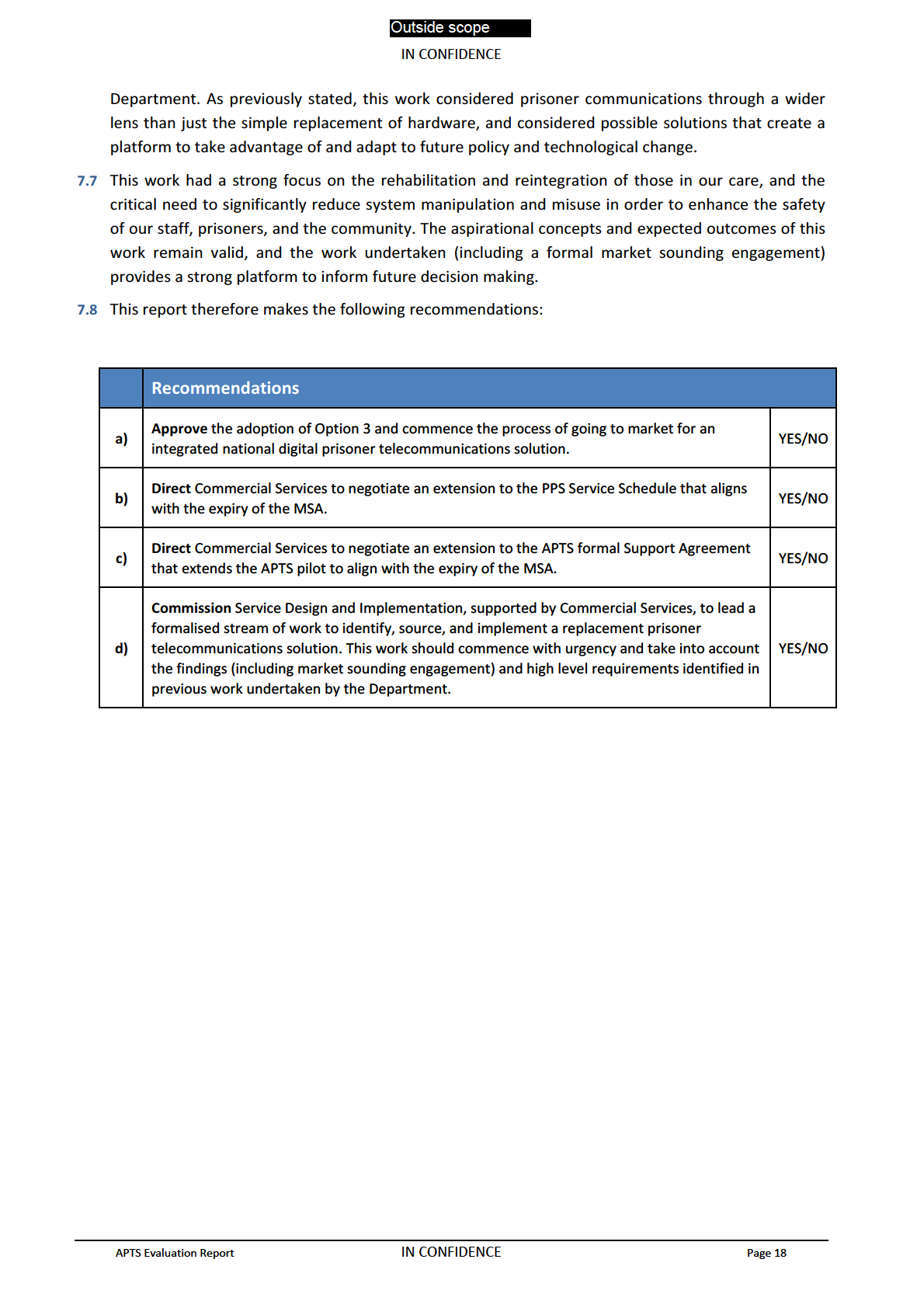
the 1982
under Act
Released
Information
Official
Outside scope
S 9 (2)(i), S 6(c)
the 1982
under Act
Released
Information
Official
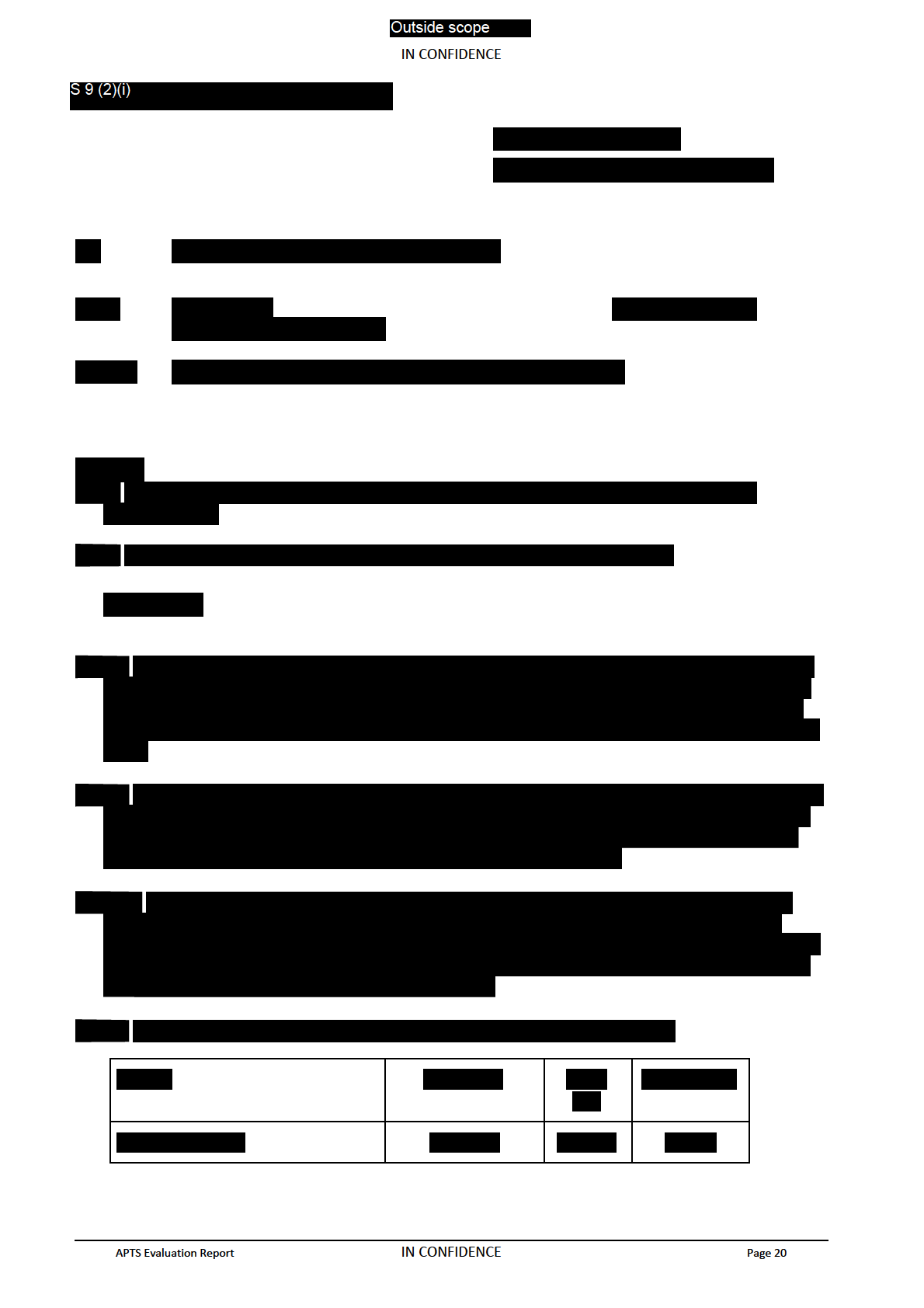
the 1982
under Act
Released
Information
Official
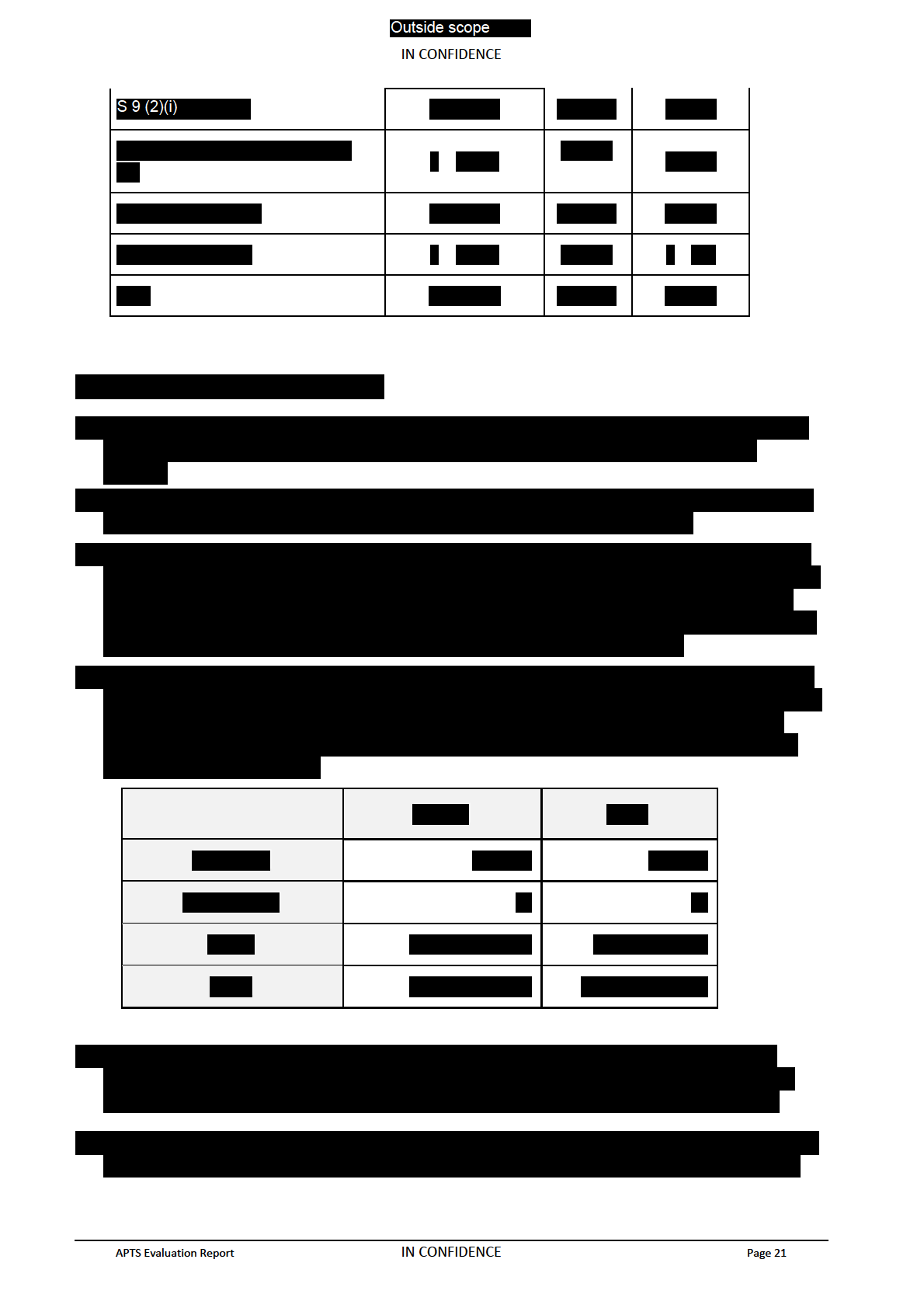
the 1982
under Act
Released
Information
Official
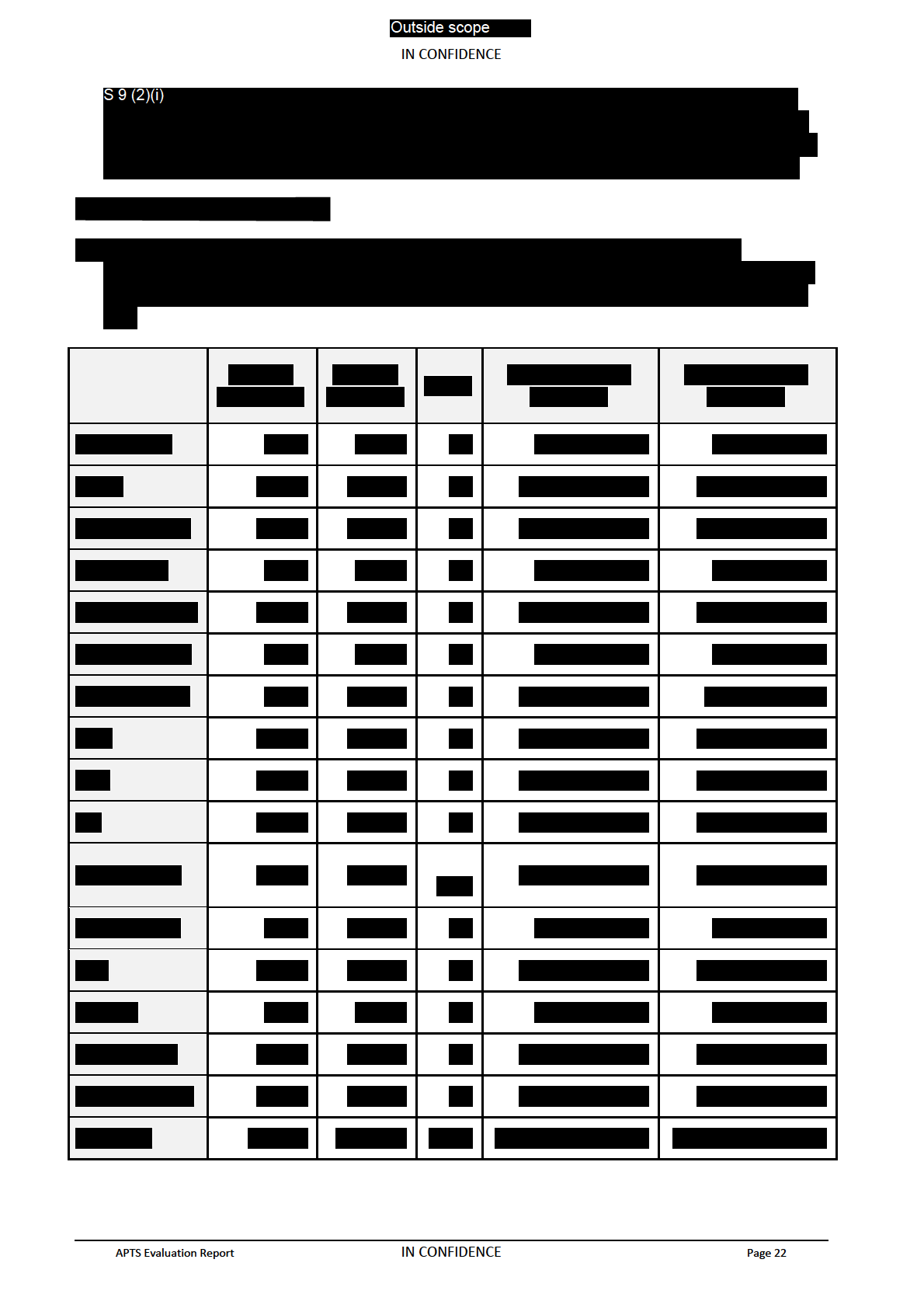
the 1982
under Act
Released
Information
Official
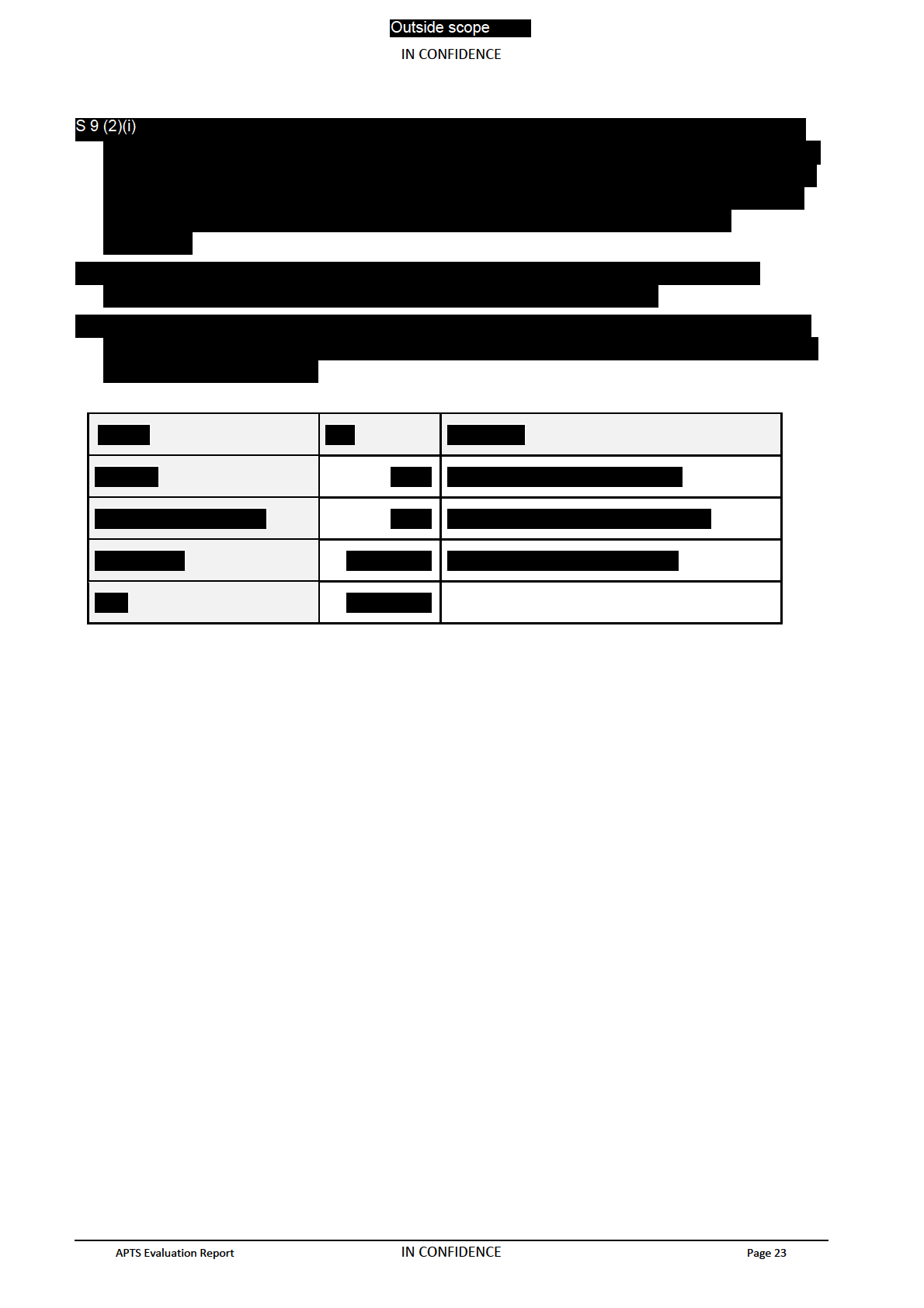
the 1982
under Act
Released
Information
Official






































